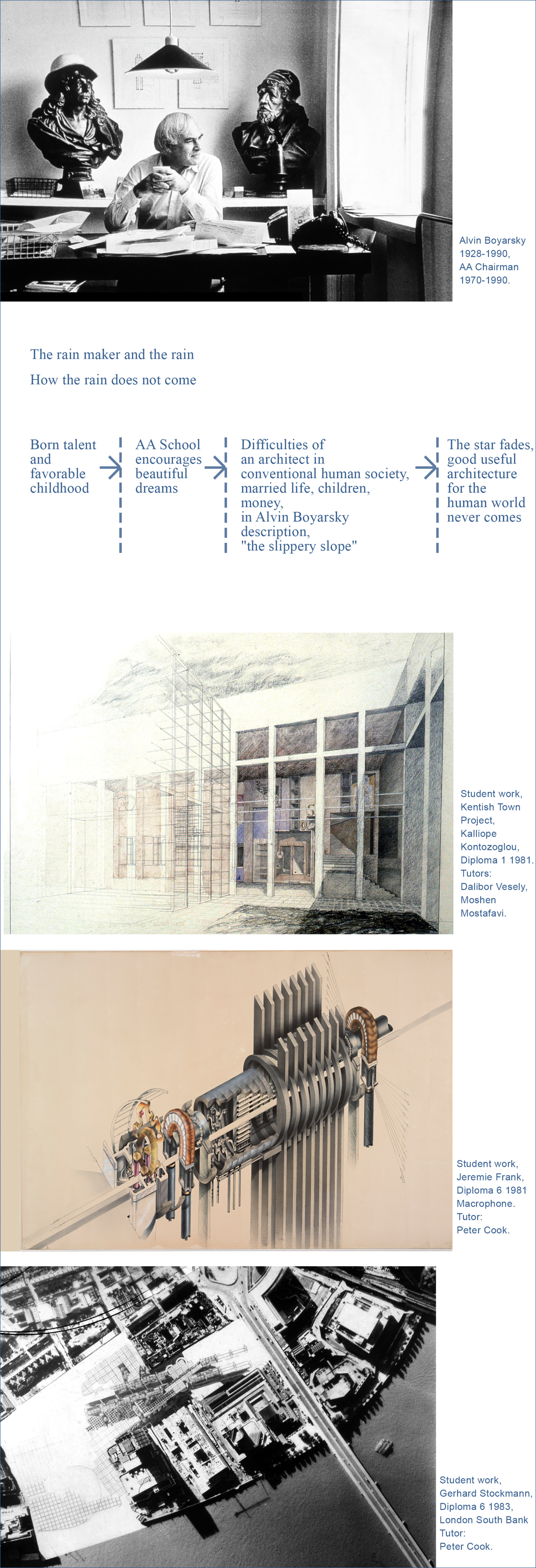Alvin Boyarsky and the Architectural Association School
Virtual coffee 2023-10-25
What is common between the photos ?

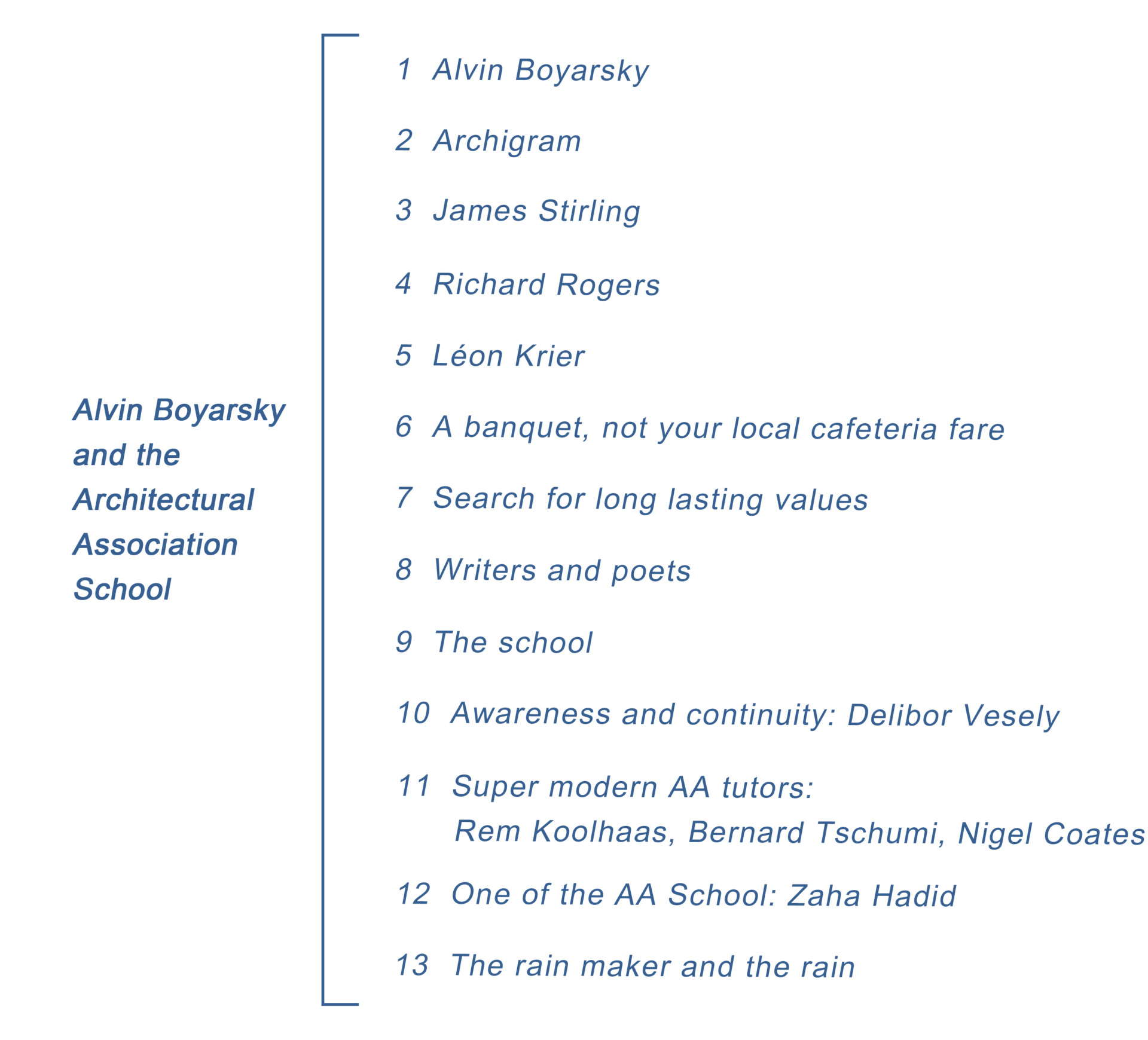
In late 20th century, no architecture school in the world could rival the fame and influence of the Architectural Association School of Architecture in London, Britain. The AA School was uncontested leader in the world for the most modern thoughts in architecture, for a possible new morning for humanity world.
The Architectural Association School was founded by 2 students in 1847 as a place for more progressive exploration in architecture. In early 20th century the AA School maintained vital value and importance in world architecture education, it was a school that Le Corbusier visited and gave lecture in 1924. But in the 1960s the AA as a private institution tried to merge into the public university system. In 1970 Imperial College withdrew from the merger talk, Imperial College’s Lord Penney wrote that the AA desired the fusion “only on their own terms”.
The AA School was on the verge of closing down, its 120 years of effort for architecture progression for naught.
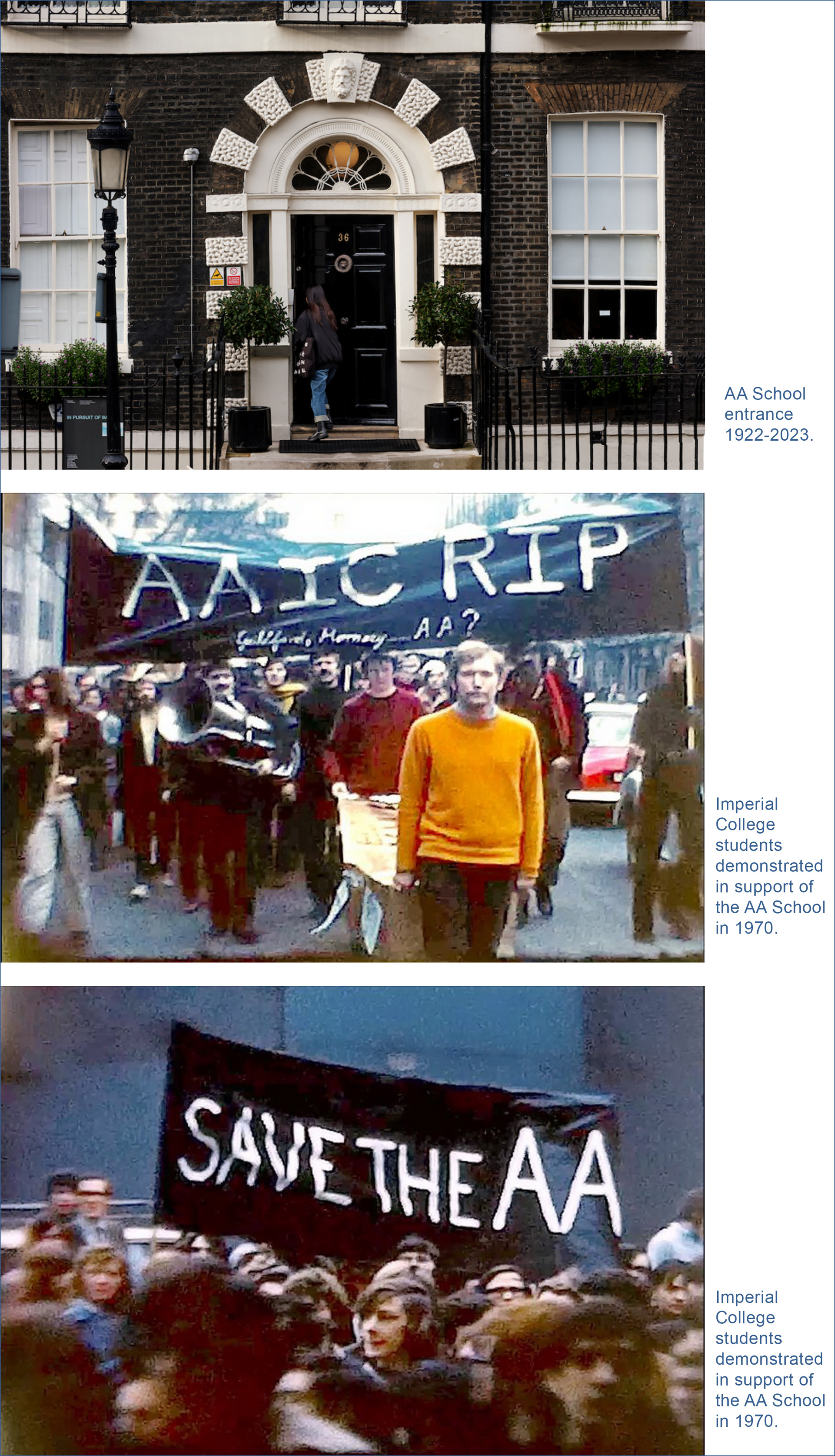
1 — Alvin Boyarsky
In bid to find a new life for the AA, the school interviewed a Canadian architect in 1970 to lead the AA School. In 1983, Alvin Boyarsky told the magazine Architectural Review about this 1970 interview.
“I was not sure if I wanted this job. So I told them a story. A town was without rain for a long time, and the townpeople prayed for rain. The town found a rain maker, the rain maker came, he asked for generous money payment. He got the money, got the women, then he climbed on his horse to leave town. The townpeople in frustration asked him, where is the rain? The rain maker replied, the rain won’t come until 24 hours after I leave town.
In 1970 I was doing well with my own work, the International Institute of Design. But I came here, the AA, instead.”
The rain maker, Boyarsky, did not leave town, but gave the AA School new international fame, in fact gave his whole life to the school.
In 2023 we may still wonder, perhaps the rain does not come after all – architecture instead of growing to a proud work of humanity, is weighted down by the inadequacy of humans ourselves.
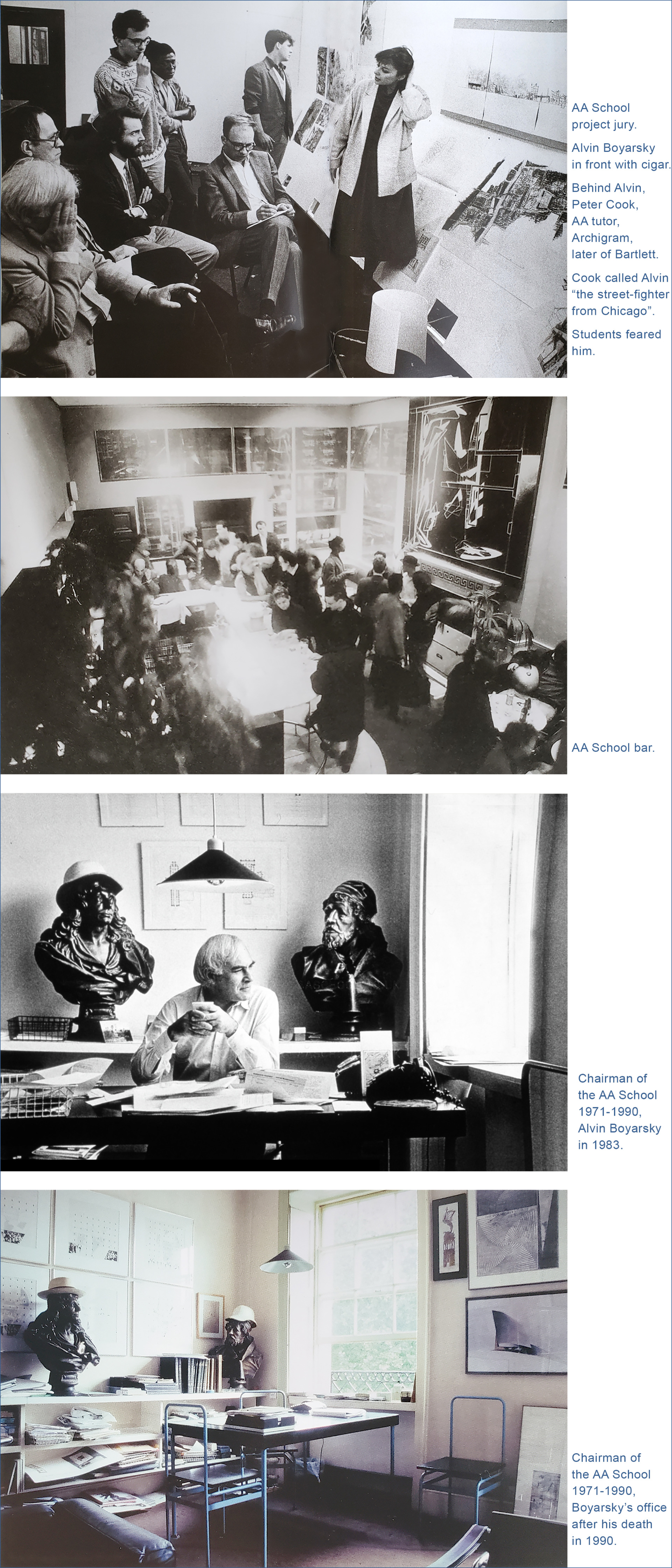
1 — Alvin Boyarsky
The head of the AA School from 1971 to 1990, called Chairman, was amazingly up to the point how the school should be run, to make the school great and give the world worthwhile architecture to think about. In 1971 Alvin made a small postcard with small print words that in fact was the whole agenda of the AA School for the late 20th century and beyond. In the postcard are the words:
A well laid table and a banquet for free ranging souls as opposed to your local cafeteria fare;
A workshop and a platform, a market place and a forum;
A cool look at the world scene;
Caught up in the Byzantine intrigues, labyrinthine curricula, procedures and objectives, as if from some former era.
In the messages, “A well laid table” stands out as the AA mission, worthwhile architecture projects laid out on a table for the world’s inspection. And the postcard spells out the great difficulties of a serious person navigating the labyrinth of architecture.
On top of the postcard agenda, the Chairman was ahead of modern world, realizing the importance of good advertising once you have worthwhile products. For 20 years the school spent expensively on elegant publications and exhibitions to advertise its design work.
In 2023 hindsight, we may see the amazingly simple, practical, and elegant criteria to help a person design architecture, suggested by the AA head of school.
But at the time, 1971 to 1990, the messages above that we can summarize so clearly in 2023, was unable to transmit through the labyrinth surrounding common young students; countless students spent AA school years desperately searching understanding of architecture.
And Alvin Boyarsky equally spent 20 years frustrated at desperate students who did not comprehend his message.
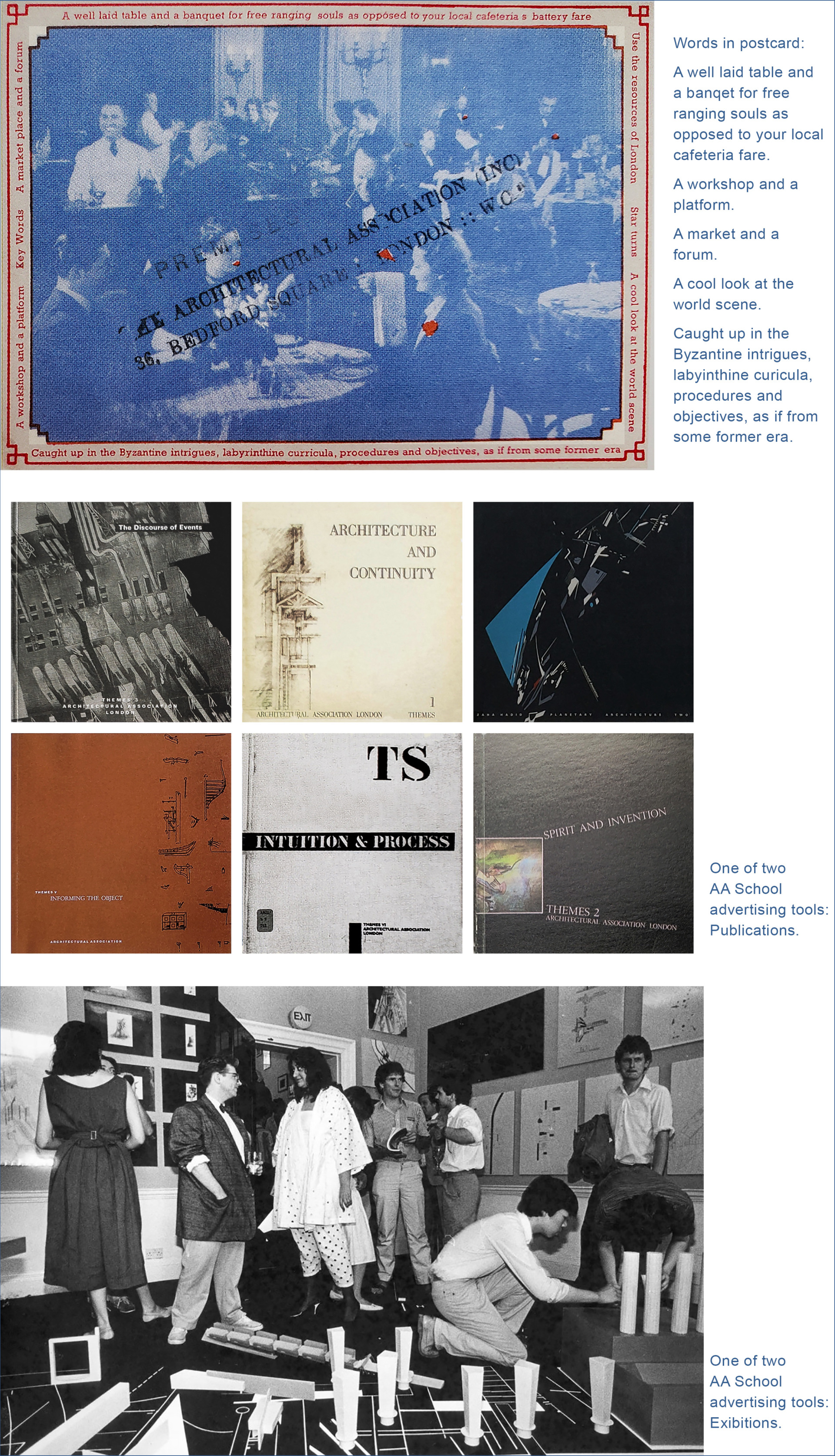
2 — Archigram
Archigram was formed by several young architects in London in 1960 who based themselves in the AA School. Archigram shaped the AA School in important ways:
Archigram was sophisticated, wild, free from institution formulas, and shocked the world. Archigram was the force that started the AA School’s modern direction, Alvin Boyarsky assuming AA leadership in 1971 merely inherited the Archigram direction and made it the formal AA agenda, the AA as a school of “free ranging souls.”
Four Archigram members became life long AA tutors, Peter Cook, Ron Herron, David Greene, Dennis Crompton. To great credit of Archigram and the AA, neither the Archigram tutors nor the AA School allowed their students to repeat little walking city designs, but made sure AA students got the right message — to design by a free ranging soul spirit. Especially in Peter Cook’s school unit, students produced greatly varied and always fresh architecture.
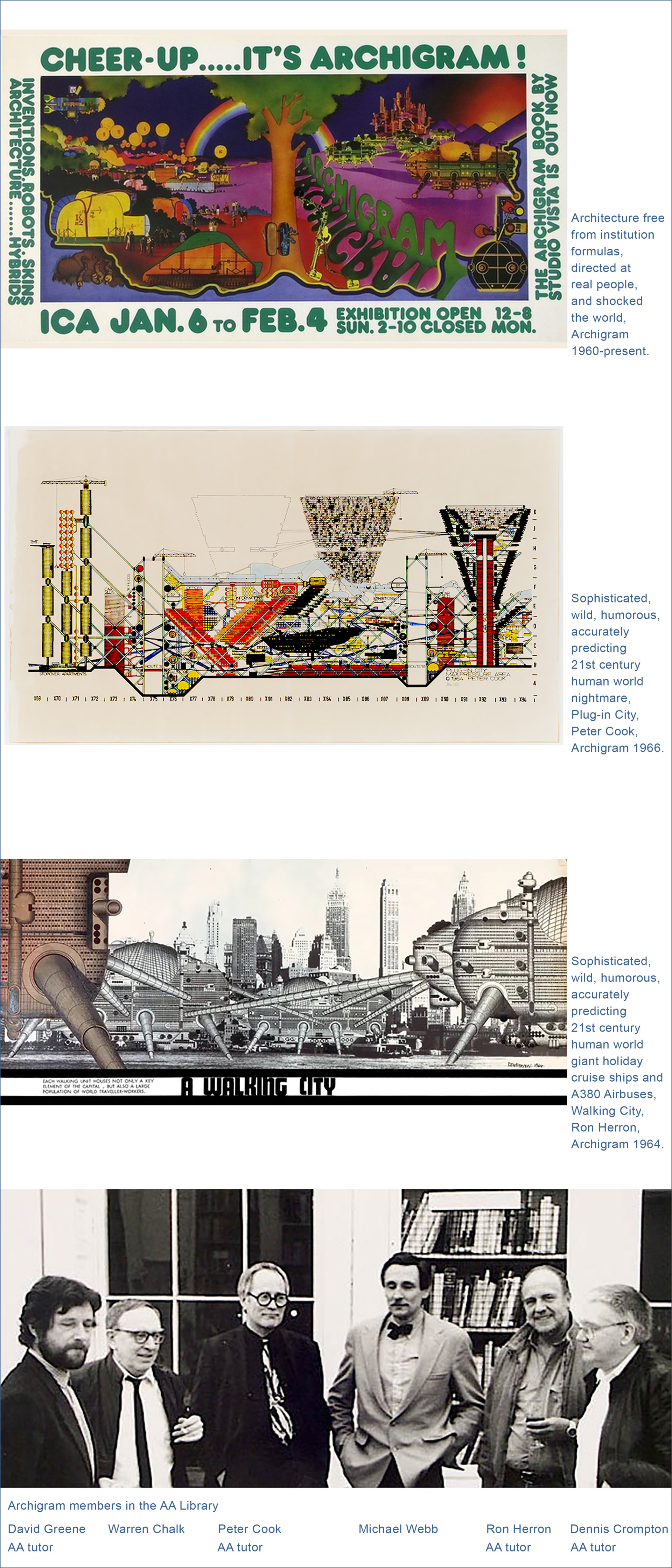
3 — James Stirling
James Stirling began teaching at the AA in 1955, because the AA was well known, well before he got famous with the Leicester University Engineering Building in 1963. For almost 30 years Stirling served the AA School, first teaching (his girlfriend before he married was an AA student), then sending his architectural assistants to teach at the AA, finally in the 1980s as RIBA External Examiner assigned to the AA. James Stirling, Archigram and Alvin Boyarsky were good friends. But James Stirling towered above the AA School, his contribution to the humanity world was unchallengeable by the AA.
We shall see that ultimately in the 1980s, James Stirling’s responsibility towards architecture broke up with the AA School rebelling too far with architecture experiment.
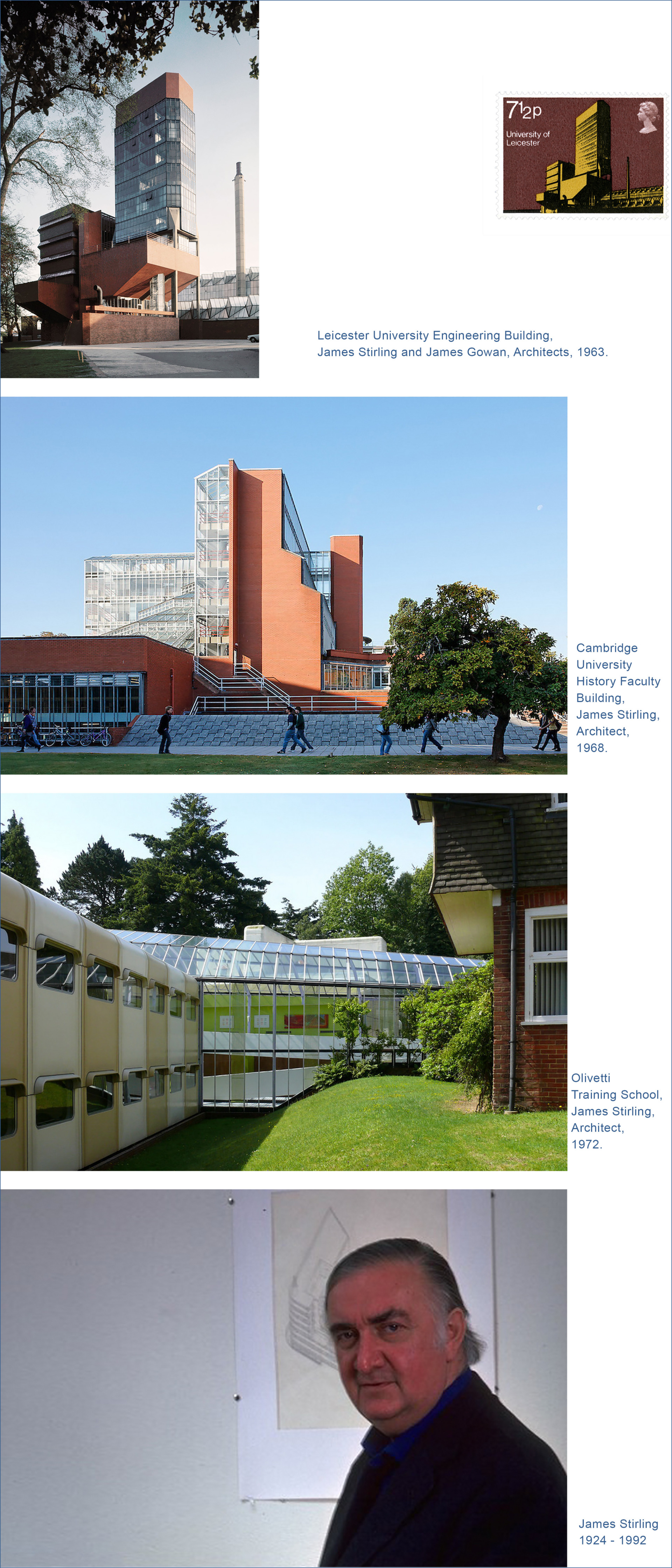
4 — Richard Rogers
The house that Richard Rogers designed for his parents in 1967 was shockingly modern and beautiful, in 2023 it is still shockingly modern and beautiful.
The Pompidou Centre that Piano + Rogers Architects completed in 1977 signified to the human world a beautiful new morning, in 2023 it still signifies to the human world a beautiful new morning.
Throughout his life to his death in 2021 Richard Rogers did not tire of messaging that the human world is possible of beautiful mornings.
Rogers studied at the AA 1954-1959, as did his Pompidou Centre architects Mike Davies (AA Diploma 1969) and Alan Stanton (AA Diploma 1967). Rogers did not teach at the AA, but he served as RIBA External Examiner for the AA in the 1980s; Mike Davies and Alan Stanton served as AA tutors 1977-1981.
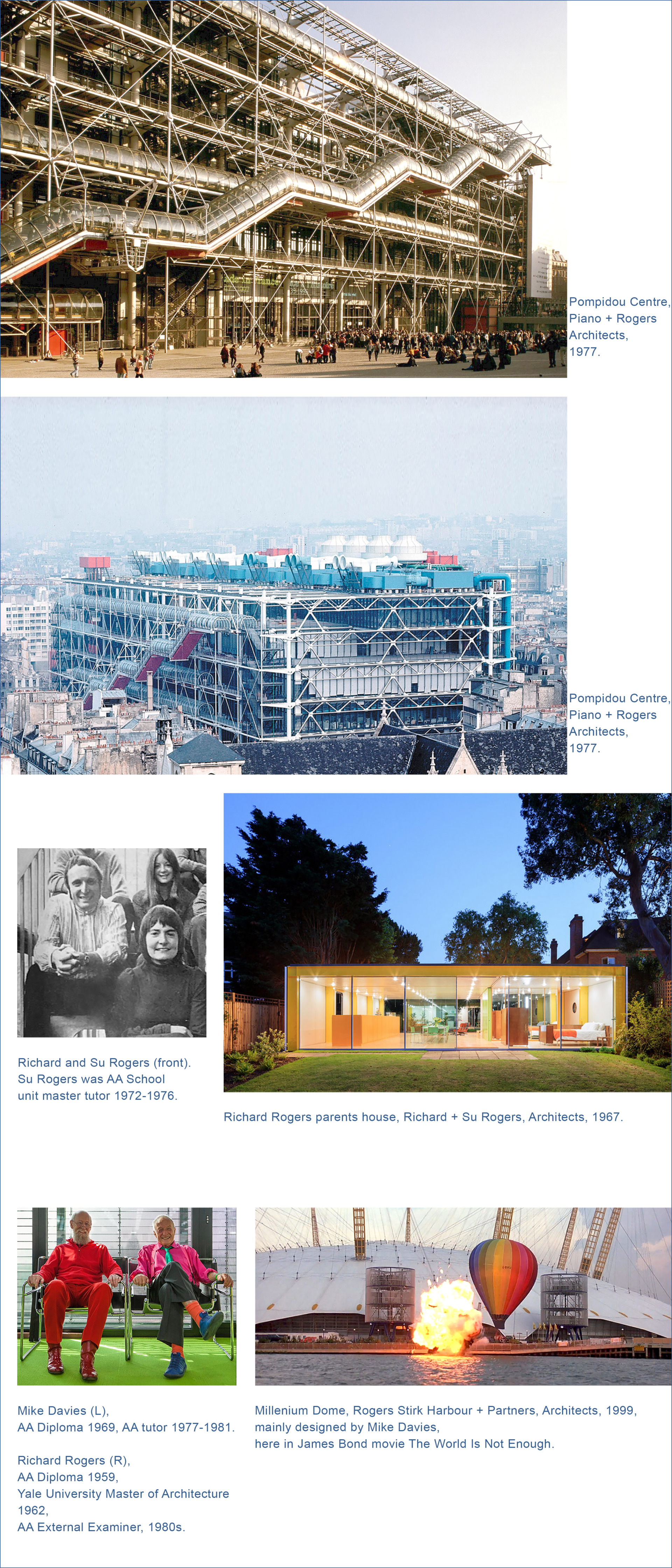
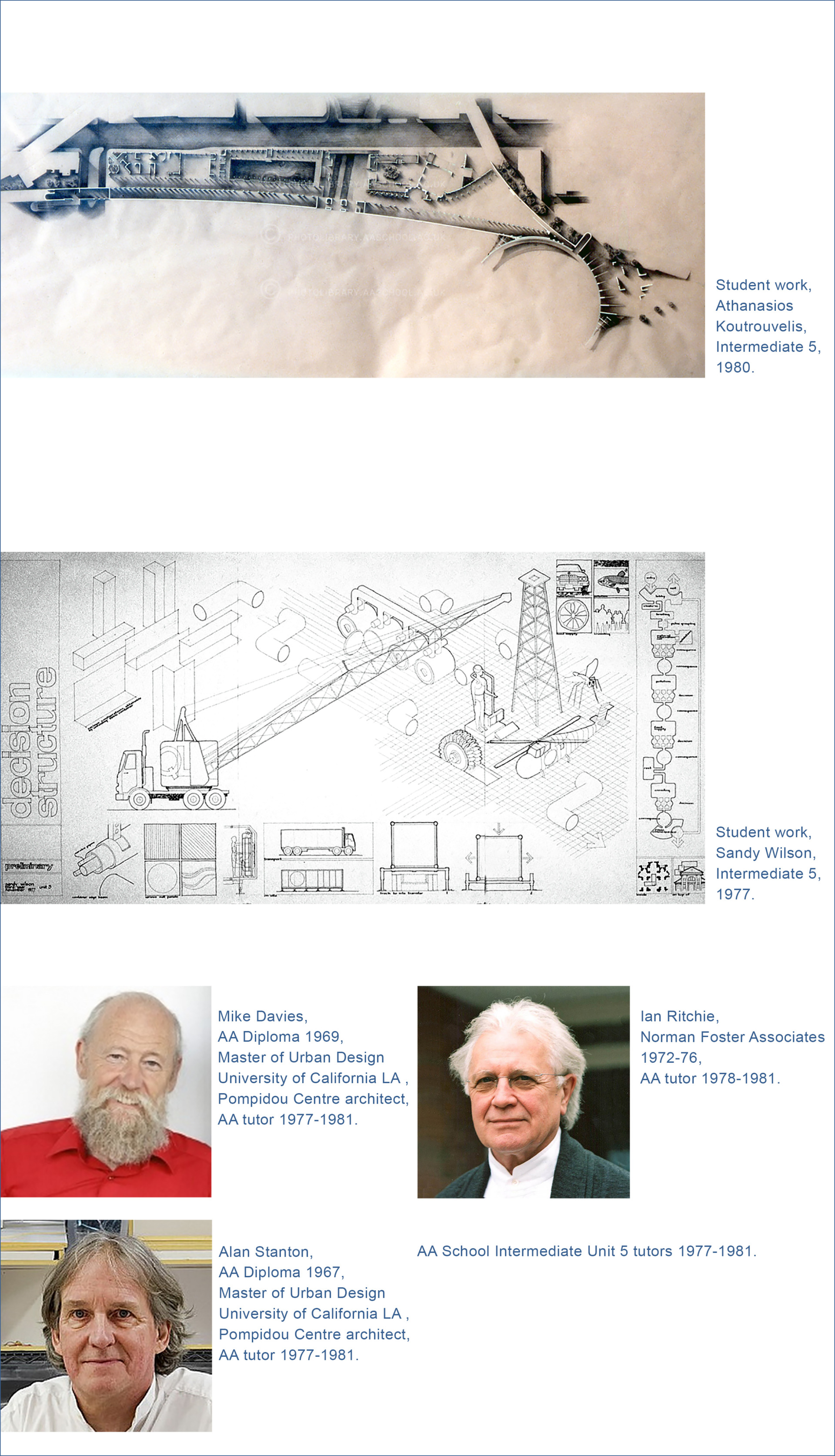
5 — Léon Krier
Léon Krier began architecture study at Stuttgart University, Germany, in 1968 at age 21, he vehemently rejected the formula teaching in the university, and dropped out after one year, never to return to university as student. In 1969 he sent his drawings to James Stirling in London, was surprisingly hired by Stirling, in 1969-1973 produced presentation drawings for Stirling projects, today Krier’s drawings for Stirling projects are hallmark drawings.
Krier and Stirling shared curious similarities. Both were big size men, both had sense of humor, and both drew small tiny drawings that are surprisingly brilliant. Stirling liked Krier, and looked at Krier’s office work every day. It must be a sight, 2 big size men, in Stirling’s office basement, cold without winter heating, poring over small tiny drawings.
Like Stirling’s many architectural assistants, Krier went to the AA 1974-1976 to serve as AA tutor.
From the 1970s to today, Léon Krier is world famous for proposals of humanitarian city planning. Unfortunately his built projects are disappointingly unconvincing and ugly.
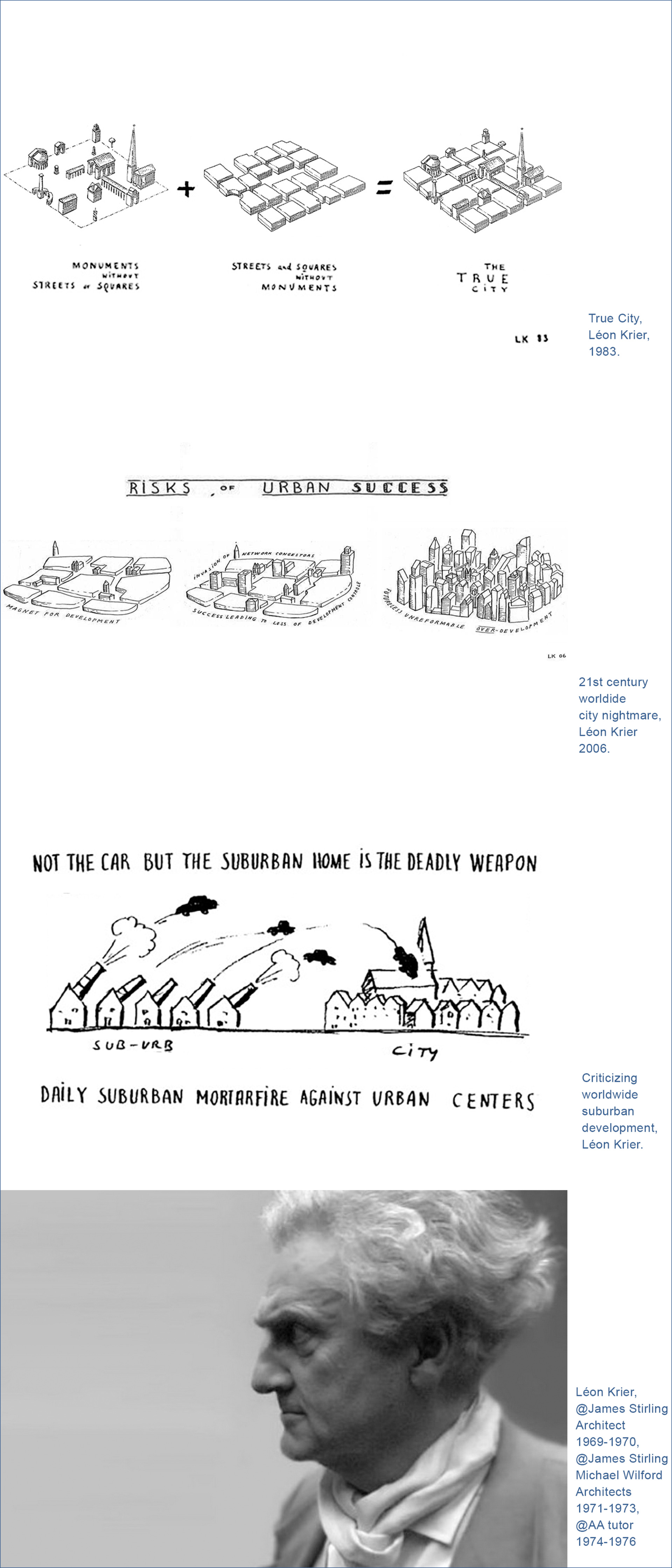
5 — Léon Krier
In worthwhile note, in Krier’s Intermediate Unit 10 in 1975 was a student Zaha Hadid. From 1982 to her death in 2016 Zaha Hadid achieved world fame as architect, she designed numerous buildings for Beijing, China, and elsewhere in China, including the Beijing Daxing International Airport, 2019. More about Zaha Hadid later in this series.
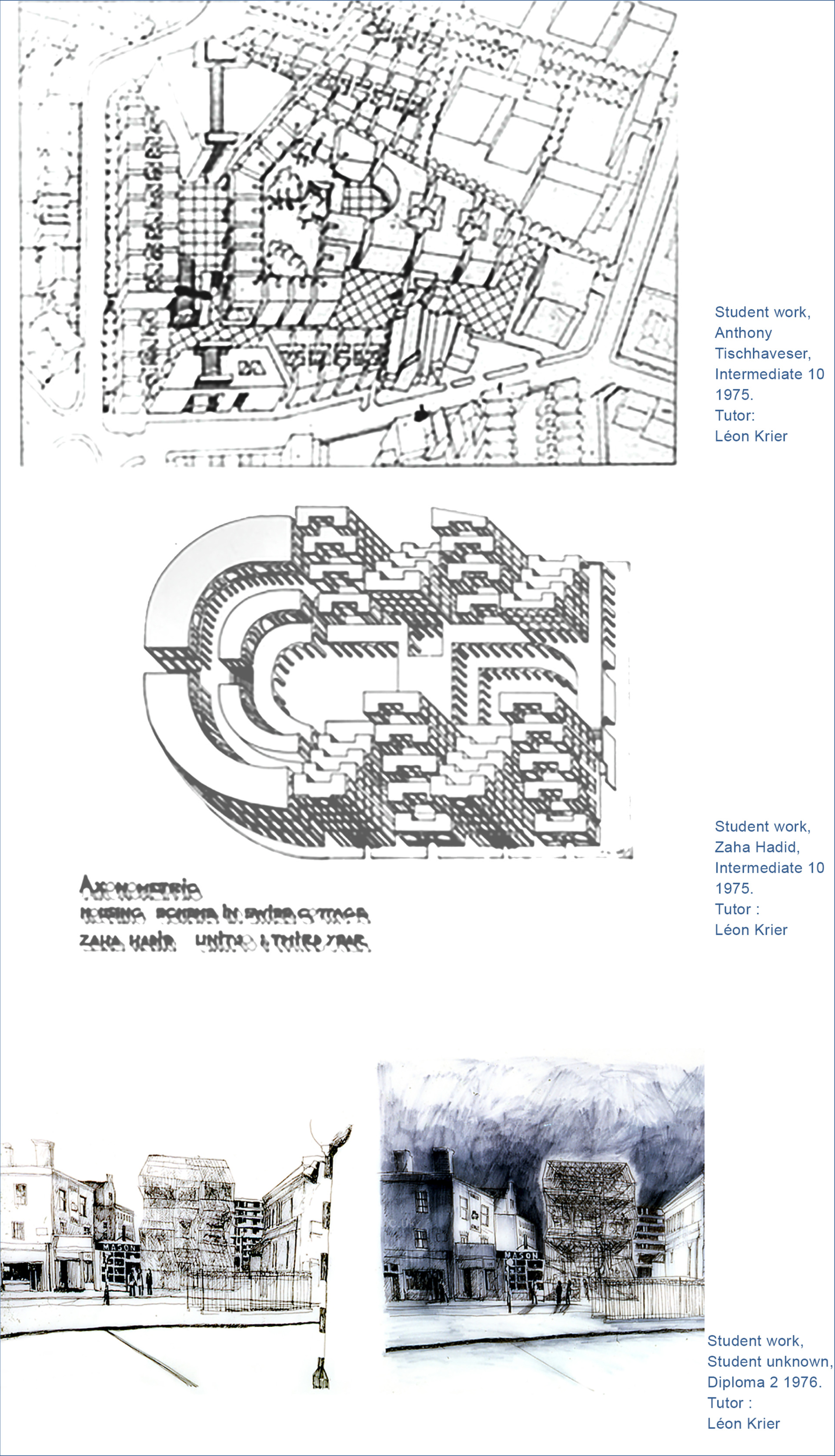
6 — A banquet, not your local cafeteria fare
The AA School in 1971-1990 was without rival, even remotely, the forefront of modern architecture experiment. And the work of 5th year AA student Paul Shepheard in 1972 left even fellow AA students behind, in intelligence, sophistication, and maturity.
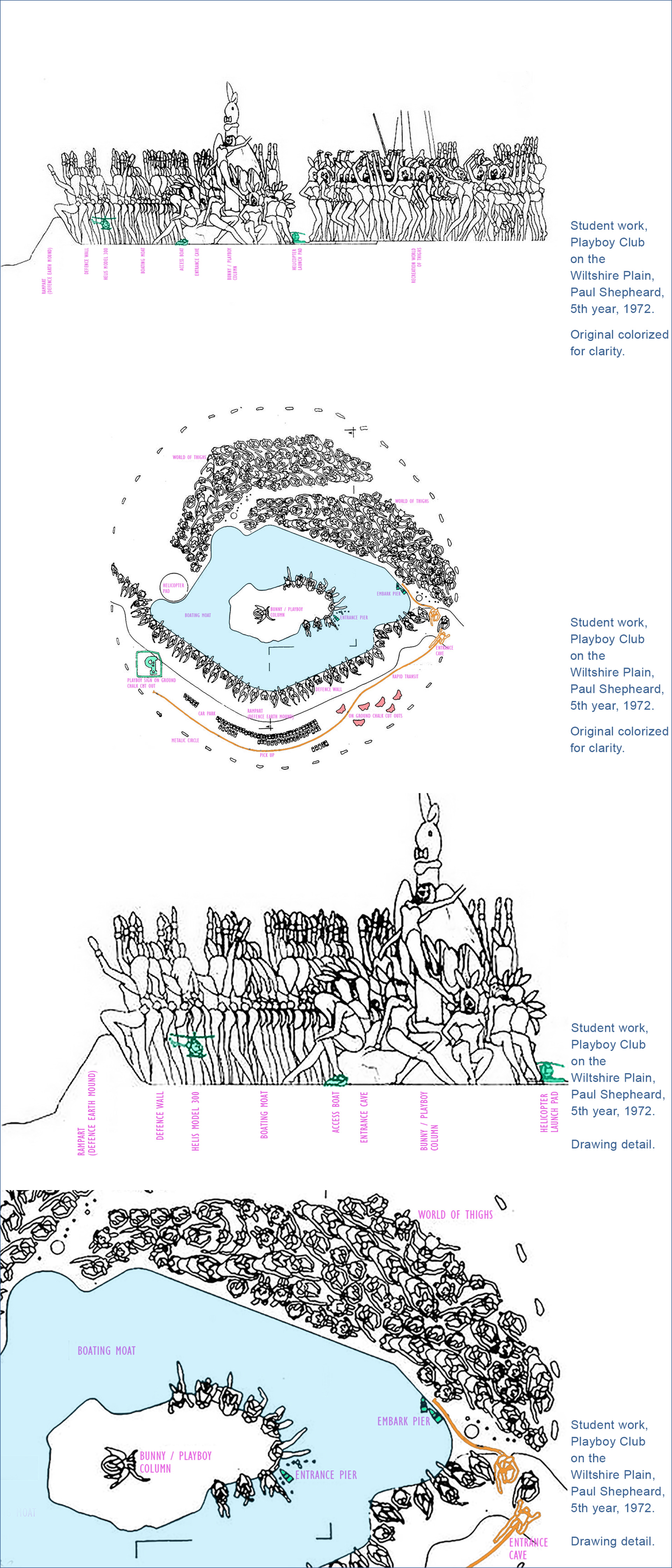
6 — A banquet, not your local cafeteria fare
Who would know that the Rolling Stones Steel Wheel Tour 1989 stage set was designed by an AA graduated architect? In 5th year in 1971, Mark Fisher’s student work already foretold what he would do 18 years later for the Rolling Stones.
The stage set design was the result of discussions between Mark Fisher and Mick Jagger.
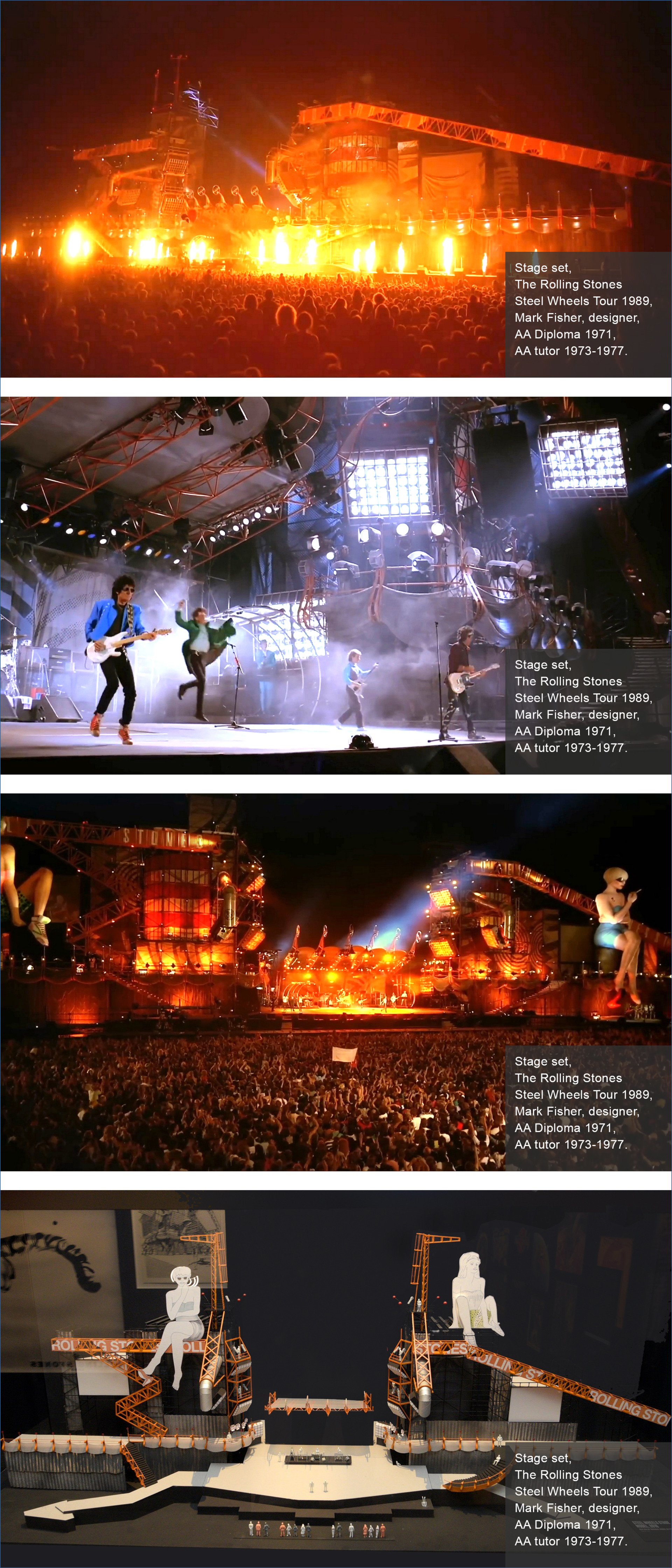

7 — Search for long lasting values
Typically fascinate and spellbind a viewer, many 1971-1990 AA student work look strangely ethereal, out of the common world.
But if a viewer looks carefully, what seem strangely ethereal and out of the common world can be explained. The students were searching beyond mediocrity of the build environment we have around us, for more long lasting values.
A few traits can be seen repeatedly in work from the AA School, they all refer to long lasting values in our human consciousness:
— Principles from Classical architecture and what they can mean in modern architecture,
— Ancient monuments and what they can mean,
— Raw nature and what they mean to human society,
— Humans and human society seen as what they truly are.
In short, many of the student work are a cry for our build environment to be worthwhile of our civilization.
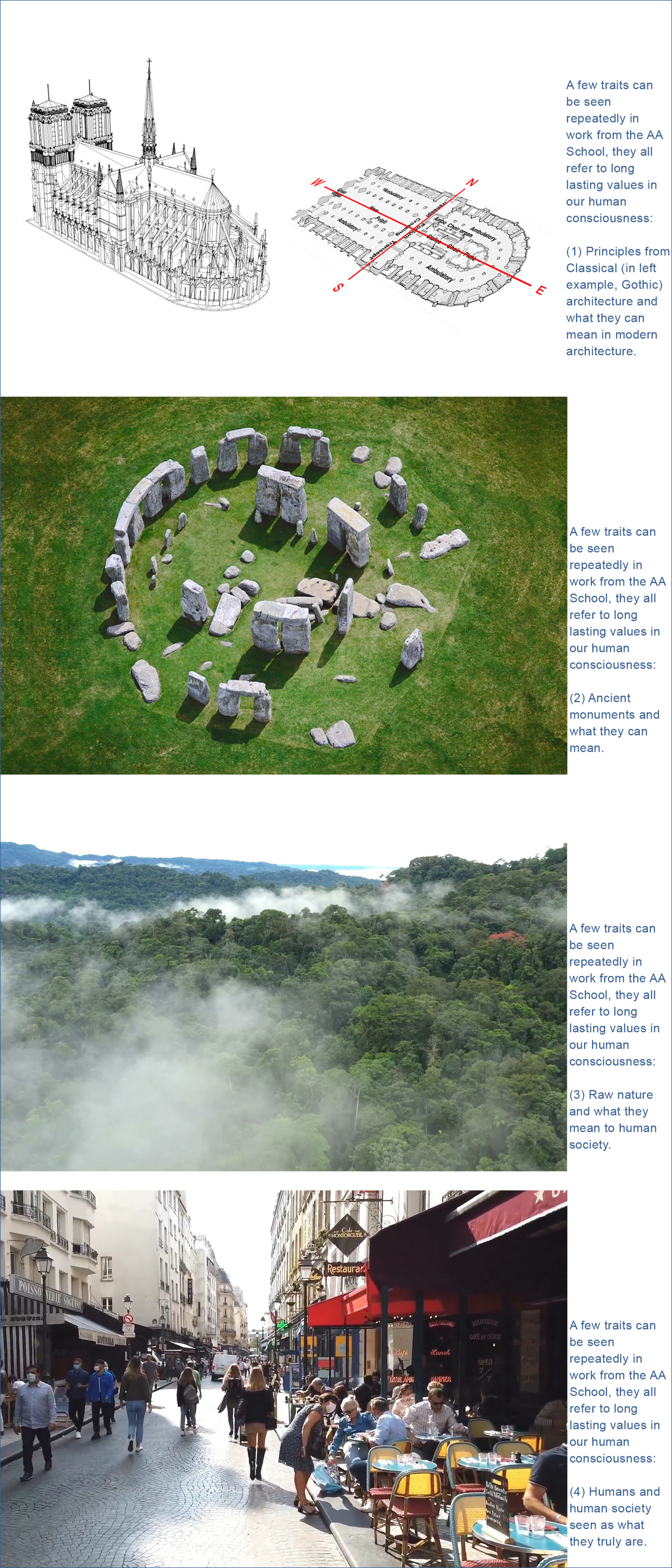
7 — Search for long lasting values
The 3rd year student work of Tony Summers in 1977 defied the student’s young age and directs a viewer to a mature ageless world.
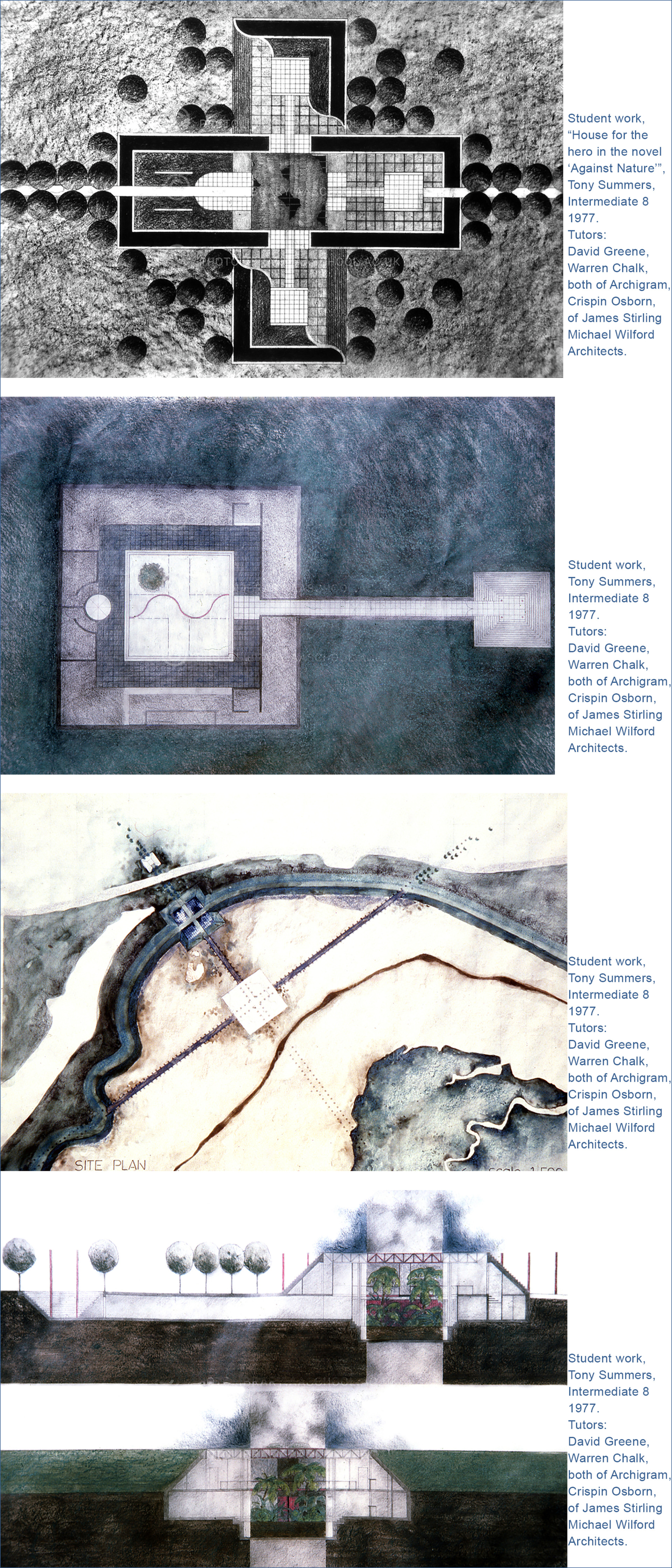
7 — Search for long lasting values
The 5th year student work of Kathryn Findlay in 1978 copied the cheerfulness of her tutors, Archigram’s Peter Cook and Ron Herron, but directs a viewer to an ageless world.
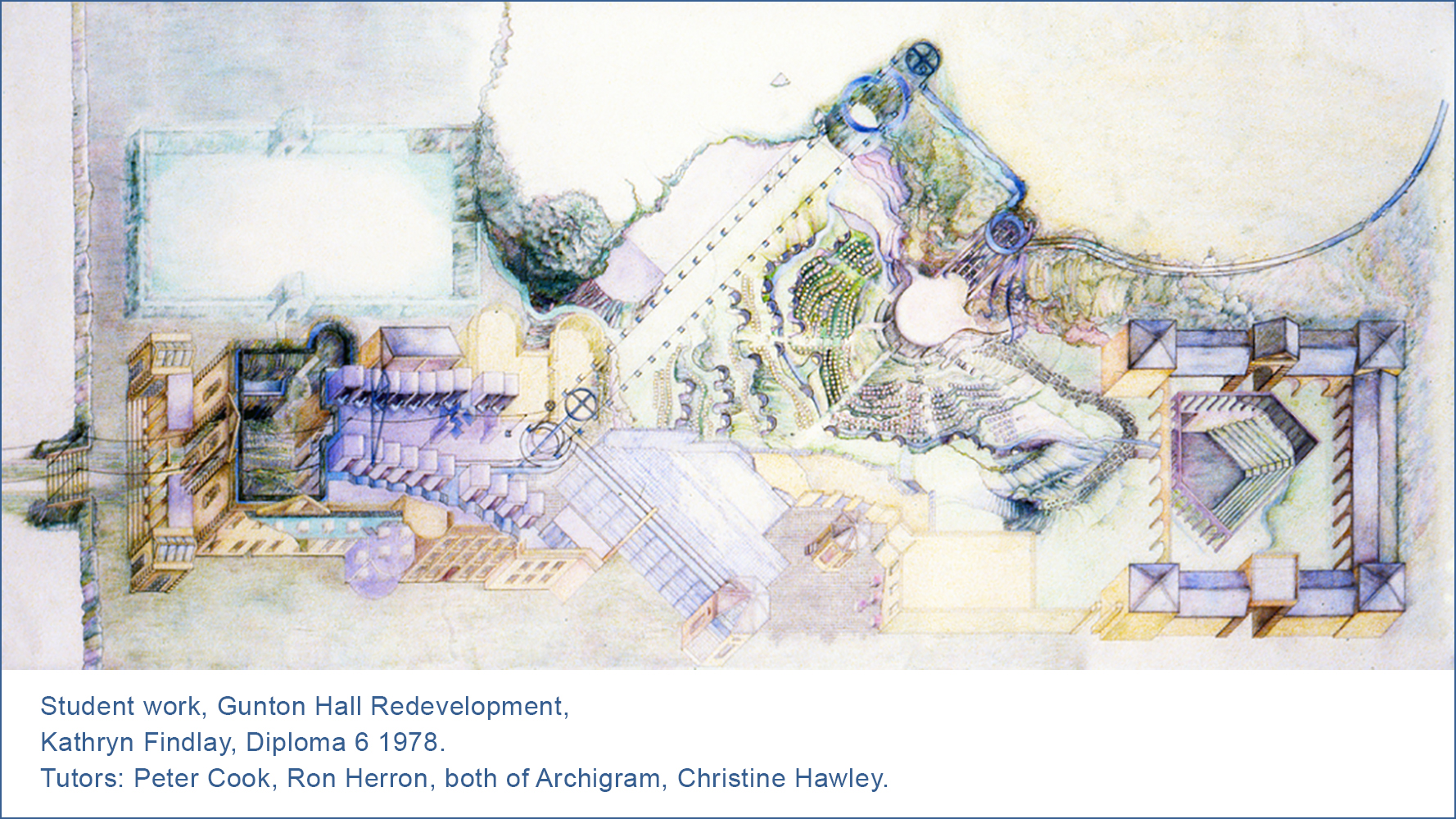
8 — Writers and poets
If we examine deep enough, buildings that transcend common building level and ascend to a level that moves and touches people are equivalent to written literature that moves people, with strong story and strong language style.
And if we examine deep enough, the best AA students are students who discover how to become a writer, and a writer with a good story and a style that can move people.
And out of this, can emerge students who discover writing that is sensitive enough, it can look like poetry.
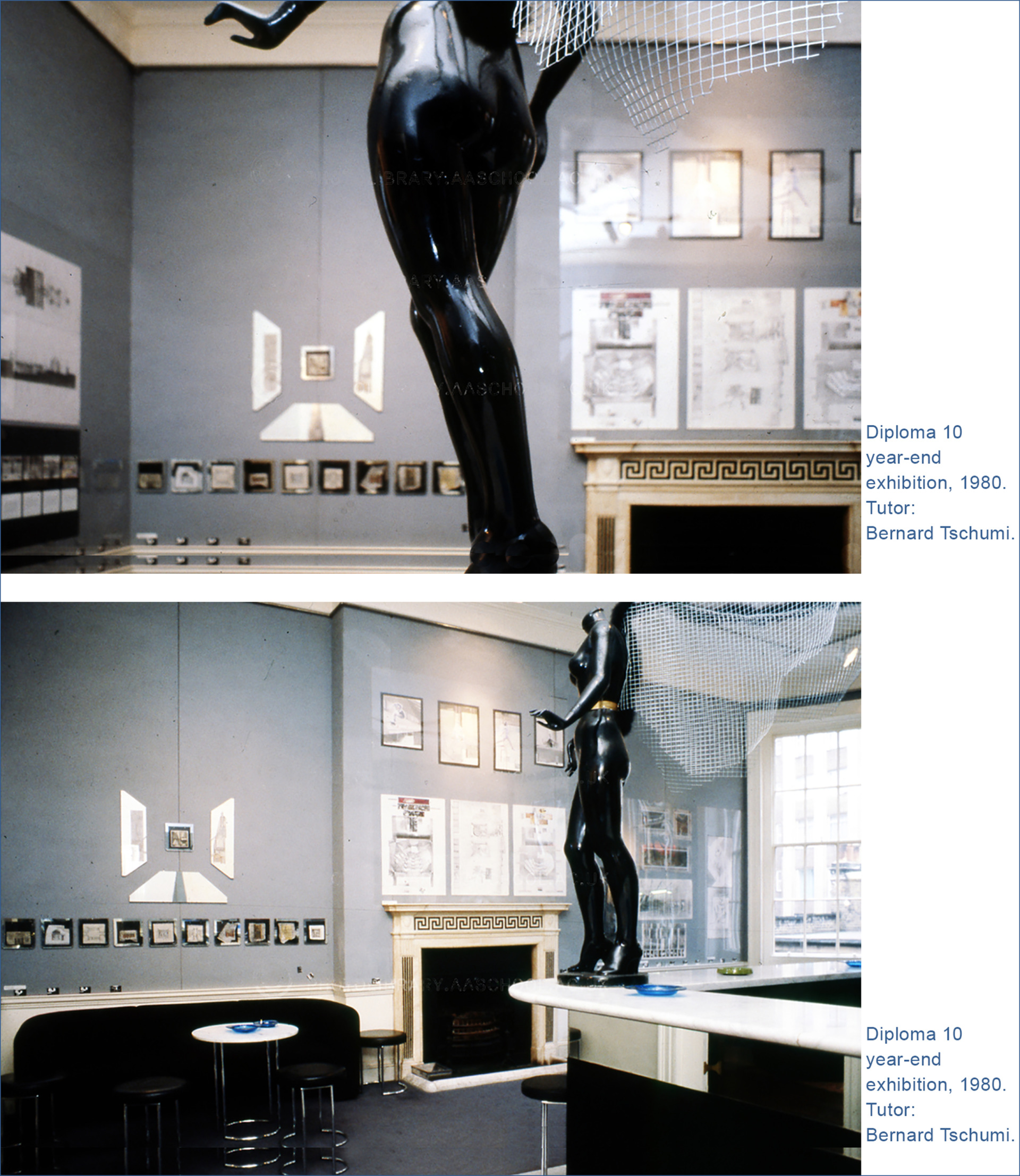
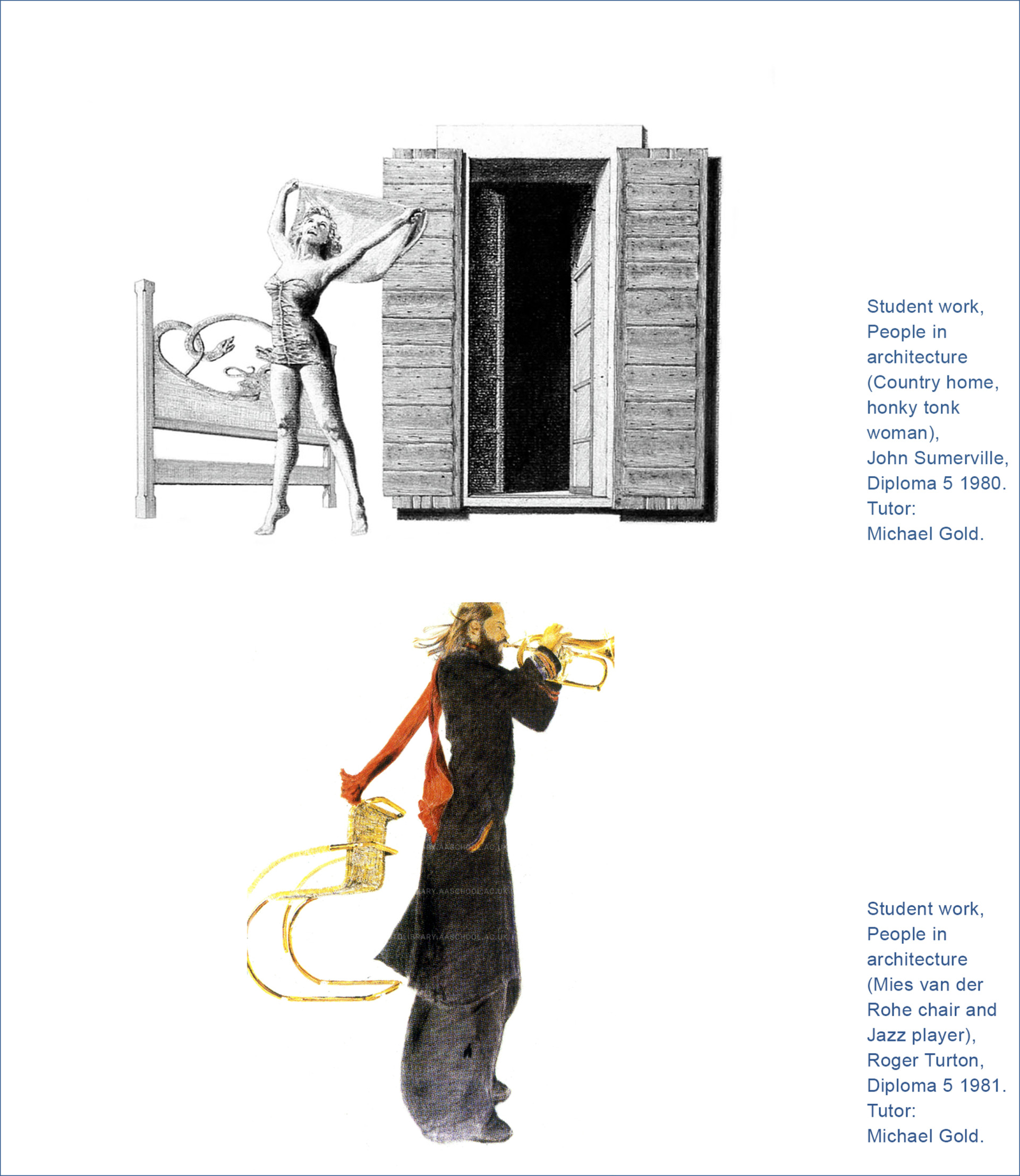
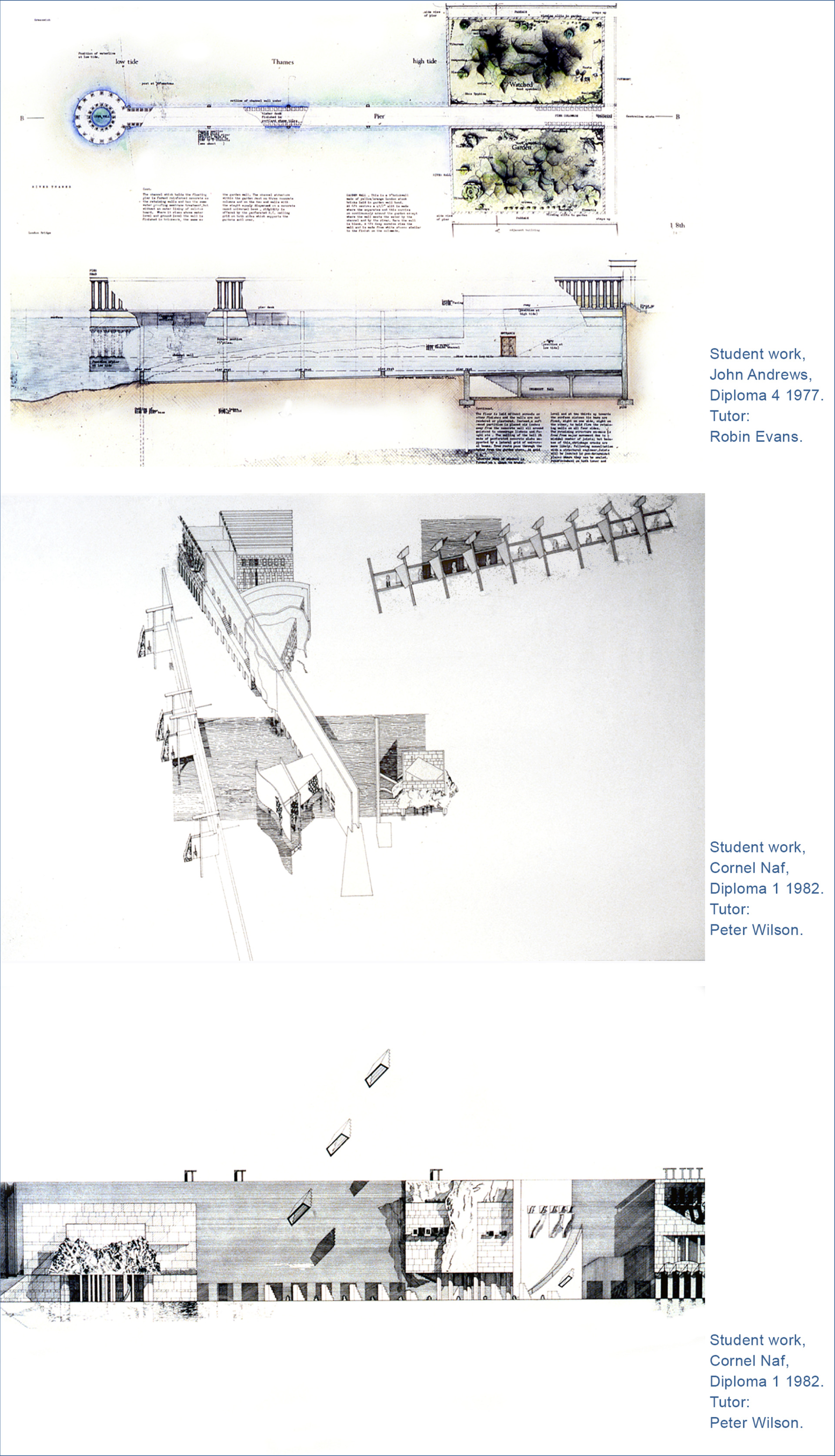
9 –The school
Alvin Boyarsky could be compared to the toughest chief executive of a modern corporate company. In the words of Peter Cook: “The former director of the Architectural Association didn’t suffer fools gladly . . . Alvin not only spent 14 hours a day “living” the AA but he became uncannily expert at knowing the names and track-records, the networks and foibles of almost every student in the school. He was able to sniff out talent, turn it over, give it a rough time . . . He interrogated, he hustled, he transmitted to them much of his voracious reading that spanned from theory to history to historical gossip along with a pretty good ear for the here and now.” (Architectural Review and Architects’ Journal Alvin Boyarsky obituary).
The schoolwork requirement for AA students cannot be more minimal: 2 papers per year, plus one year-end work review. But the year-end work review would be a toughest review a person may encounter in their lifetime, which all students would dread and fear.
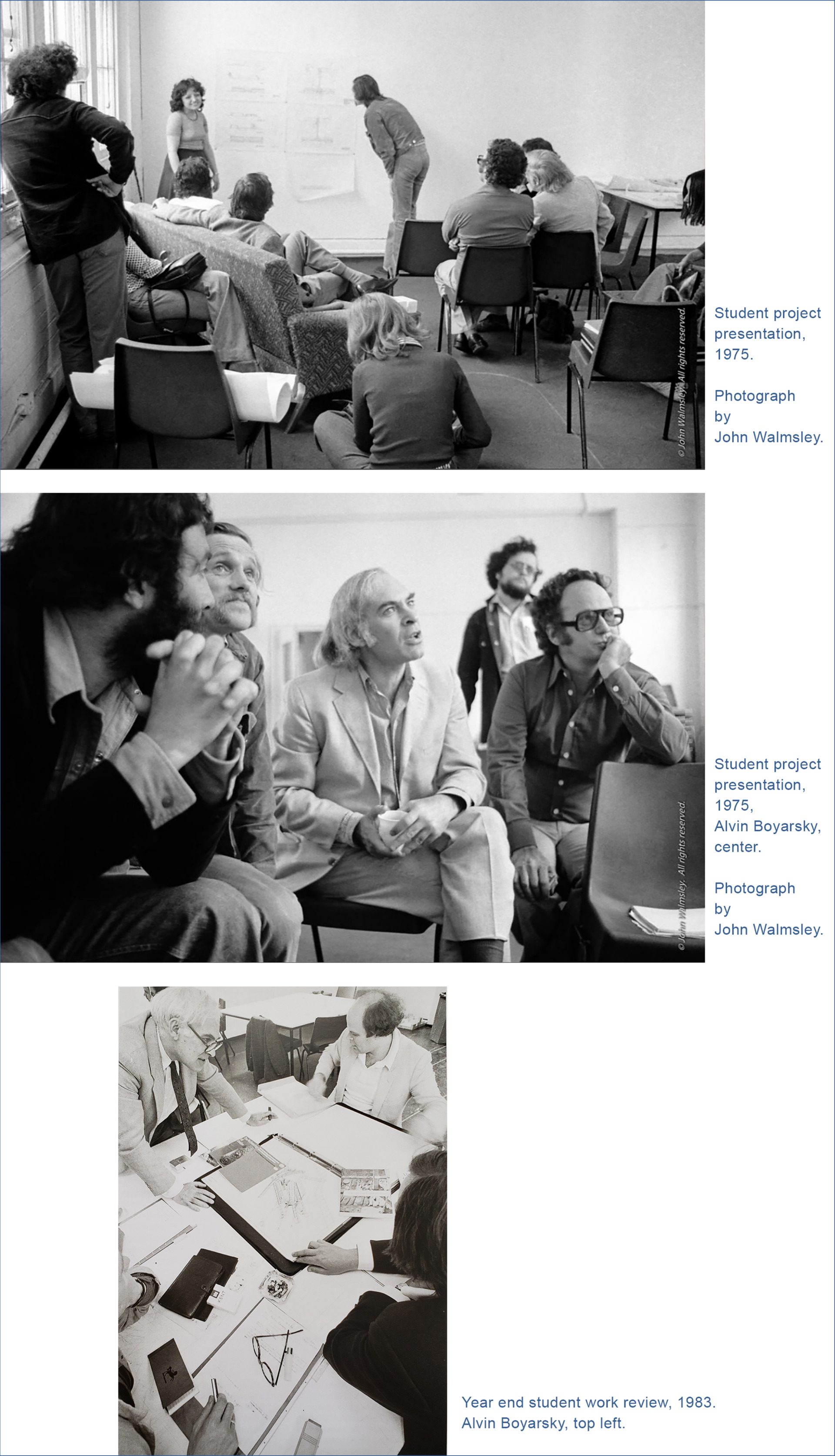
9 — The school
Some AA tutors were the cream of previous AA graduates. To a struggling student at the AA, the young AA graduates and tutors seemed to know and hold the secret to architecture heaven.
The passing of time and years show that the tutors who had once seemed infallible, do not hold the secret to architecture heaven after all. The students themselves hold the key to their own future.
AA students under the Alvin Boyarsky agenda were under great pressure to immediately understand the great labyrinth of architecture. This is a physically impossible demand, unless a student came to the school as born genius, or had begun architecture training since childhood from family parents. Many students failed. This was the true reality of the AA School.
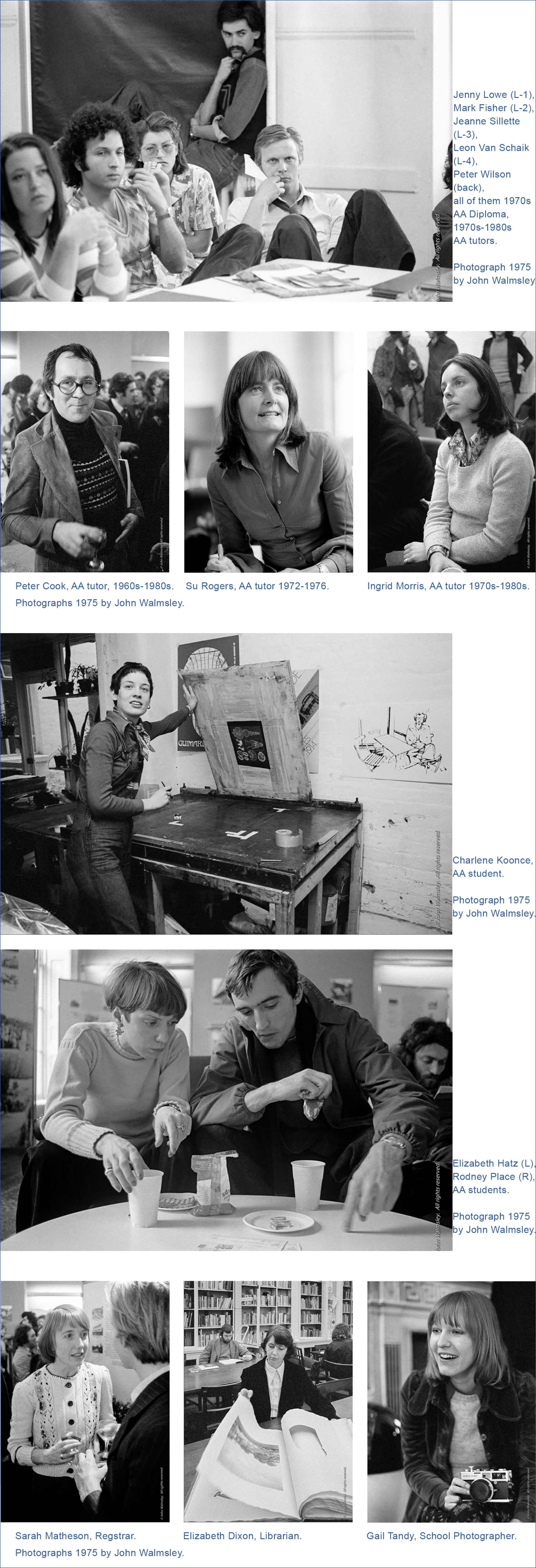
9 — The school
Bernard Tschumi (1944- ), AA tutor 1970-1979, later Dean of Columbia University Graduate School of Architecture, influenced the AA greatly with an analysis of architecture, once more aimed to shock the AA and the world. Bernard Tschumi is well known internationally as a revolutionary modern architect. More about Tschumi later in this series.
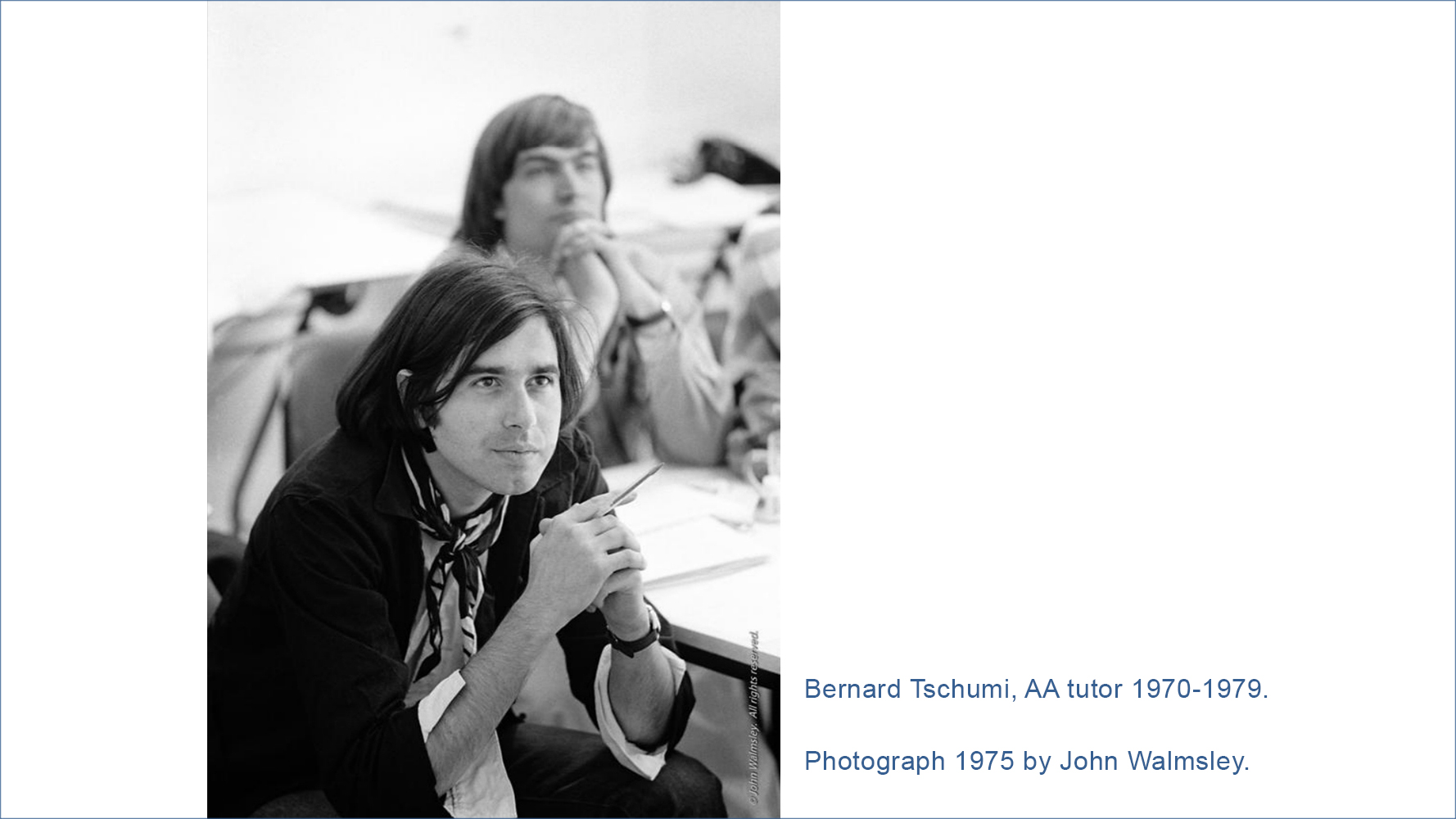
9 — The school
Charles Jencks (1939-2019), Harvard PhD English Literature, AA tutor in architecture history in 1970s-1980s, was well known in international architecture circle. It is uncertain if Charles Jencks really influenced AA students despite his being well known in world social circles. In AA teaching years Jencks championed a theory of Postmodern Architecture, essentially a theory looking at architecture as a joke.
Charles Jencks married Maggie Keswick (1941-1995), daughter of a Scottish businessman who was friend of Chinese leaders Chiang Kai-shek and Zhou Enlai, with high business in China and Hong Kong including Jardine Matheson. Maggie Keswick grew up in Shanghai and Hong Kong, studied at the AA, wrote a book “The Chinese Garden”, an insightful book on Chinese landscape architecture. Maggie Keswick was a gentle lady without high society attitude, and sadly passed away young.
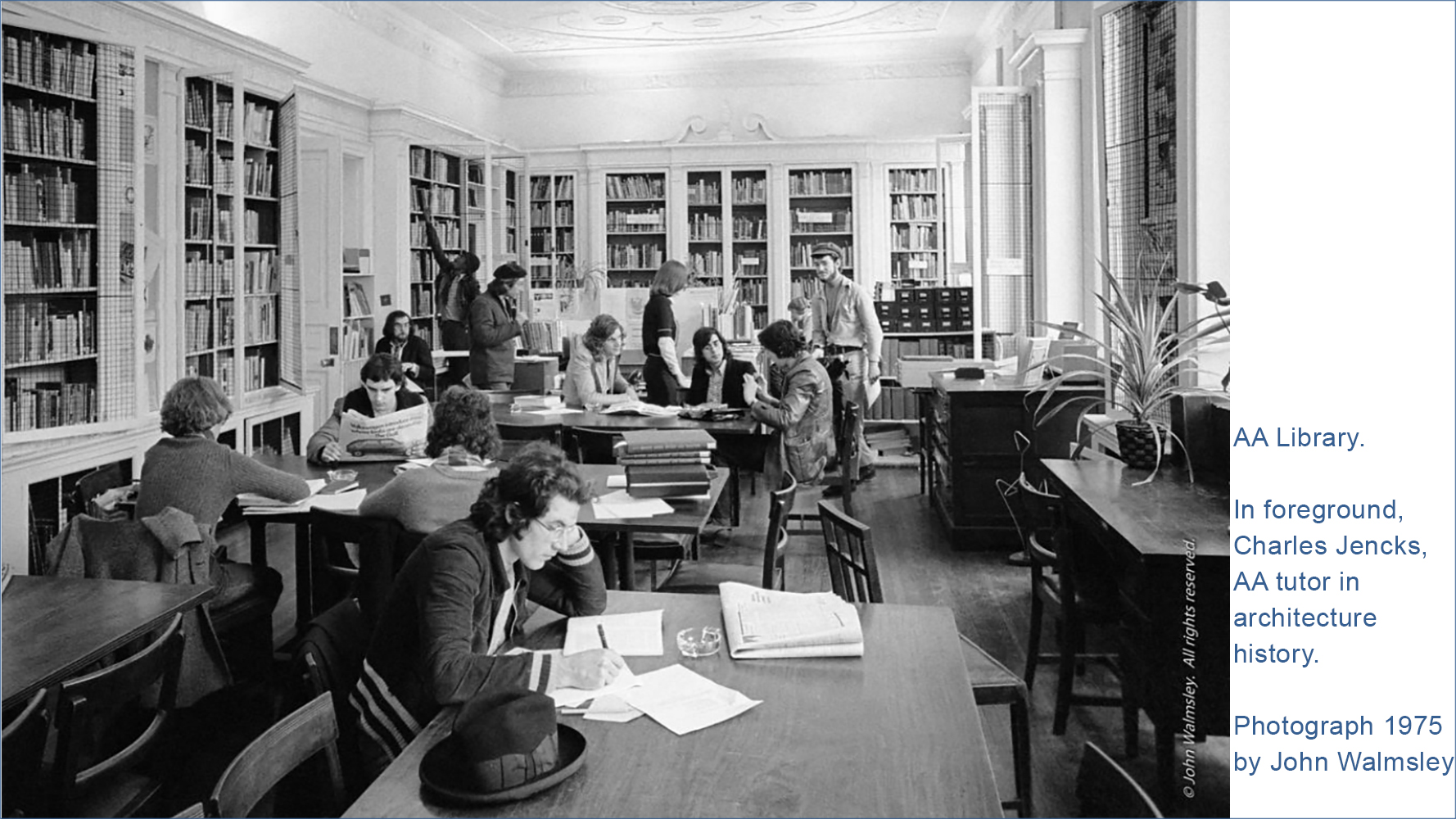
9 — The school
The AA School in 1970-1990 occupied 3 row house units built 200 years ago in 1783, originally intended for residential use. But the 3 row house units were since occupied by the AA as crowded and therefore uncomfortable campus for 500 students and more than 100 staff, teachers and international visitors.
The city of London itself is a crowded megapolis.
AA students lived in this cramped environment, and tried their best to enjoy their youth, under pressure to produce architecture that might one day shatter the humanity world.
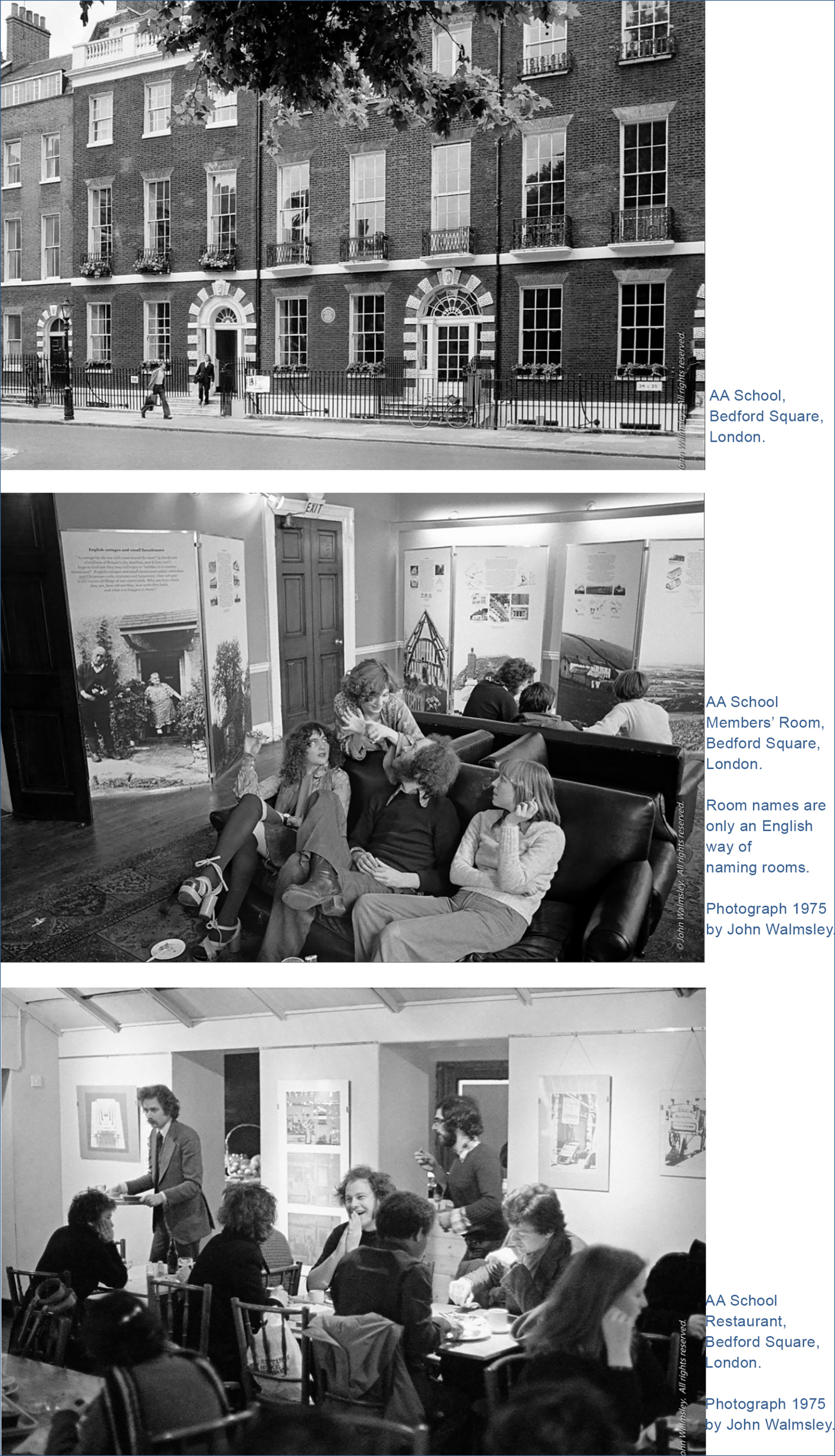
10 — Awareness and continuity : Dalibor Vesely
Dalibor Vesely as AA tutor 1968-1981 brought a unique thesis to the AA School “marketplace.” He came from Czechoslovakia, was trained as architect and scholar, and understood European cities deeply. If one simplifies his complex views, it is that architecture cannot escape from a complex network of forces, including cultural continuity, society situation, human feelings and much more. A good explanation about Vesely is in the Dalibor Vesely obituary by David Leatherbarrow.
Dalibor Vesely left the AA to teach at Cambridge University and many other universities until his death in 2015. His AA teaching only bore success in his later AA years 1978-1981.
Vesely’s co-tutor Moshen Mastafavi was later AA Chairman, and Dean of Harvard University Graduate School of Design.
In contrast to the fiercely modern AA, the student work of Vesely’s 1978-1981 AA unit directs a viewer to a world very old. This was intended to show cultural continuity of architecture. The pencil shadings were intended to show the poetics of architecture. But the pencil shading became a famous AA hallmark.
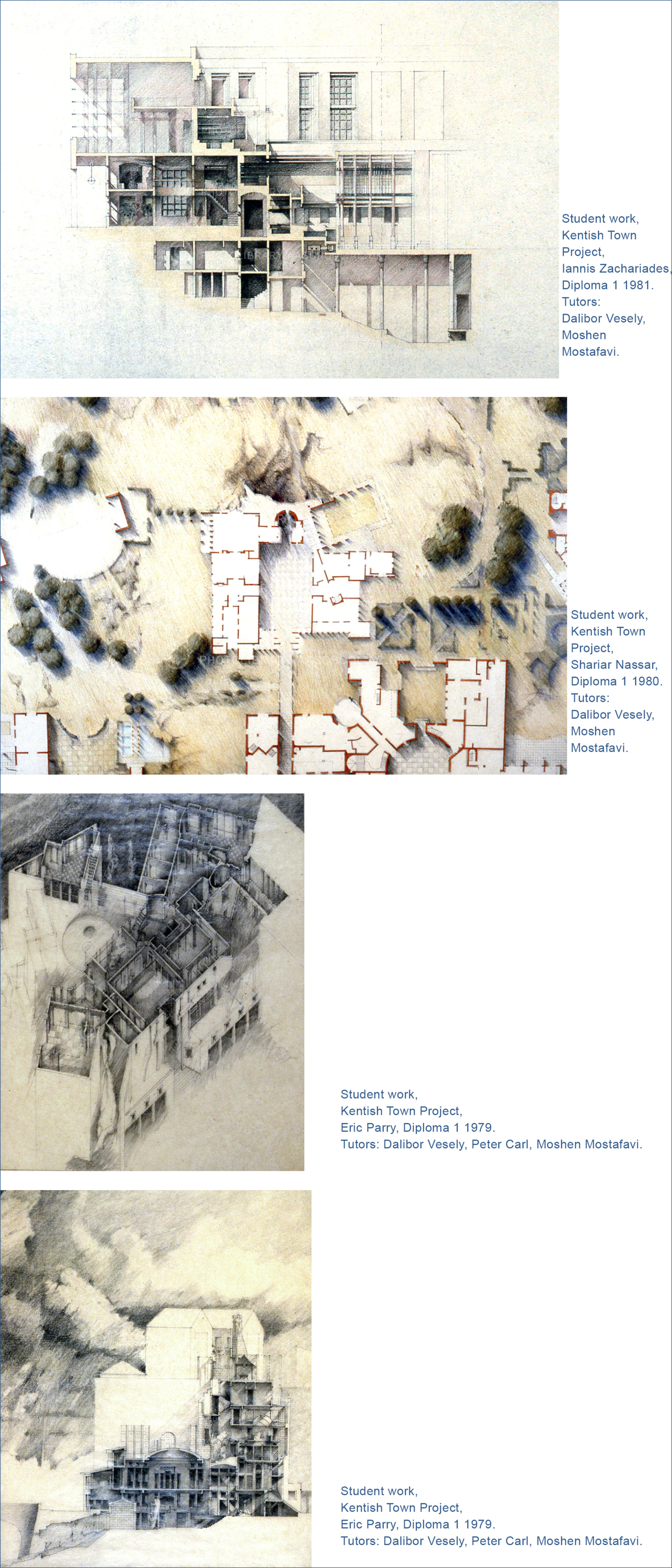
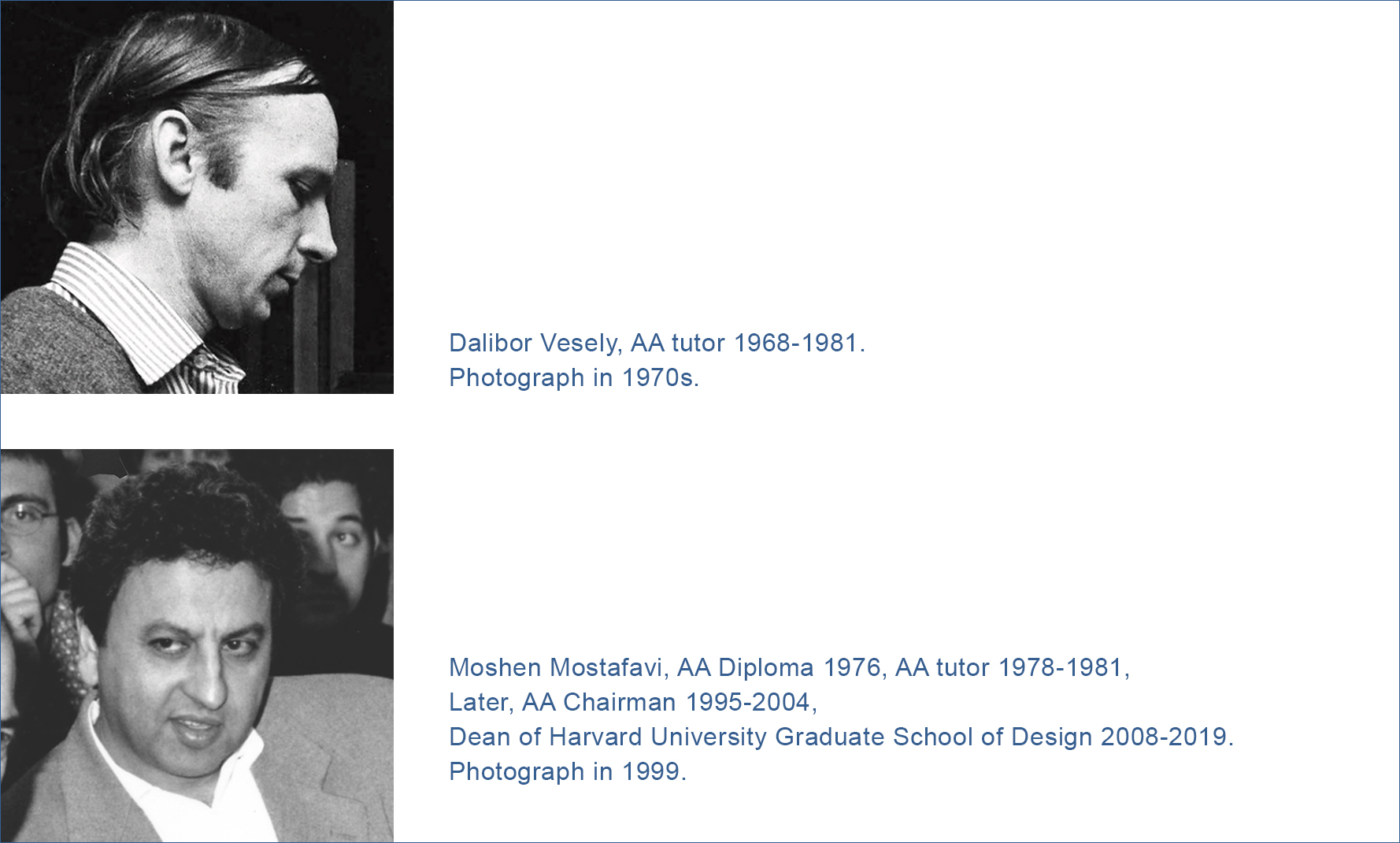
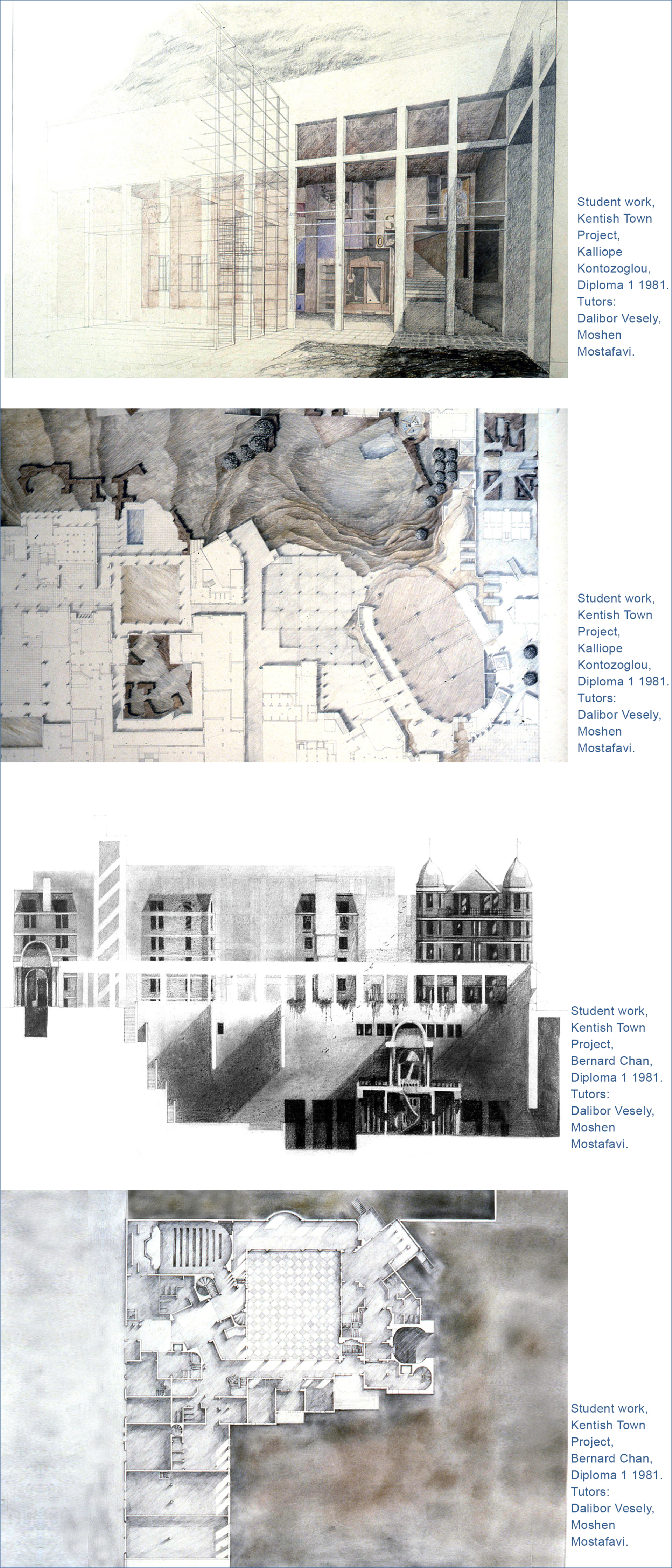
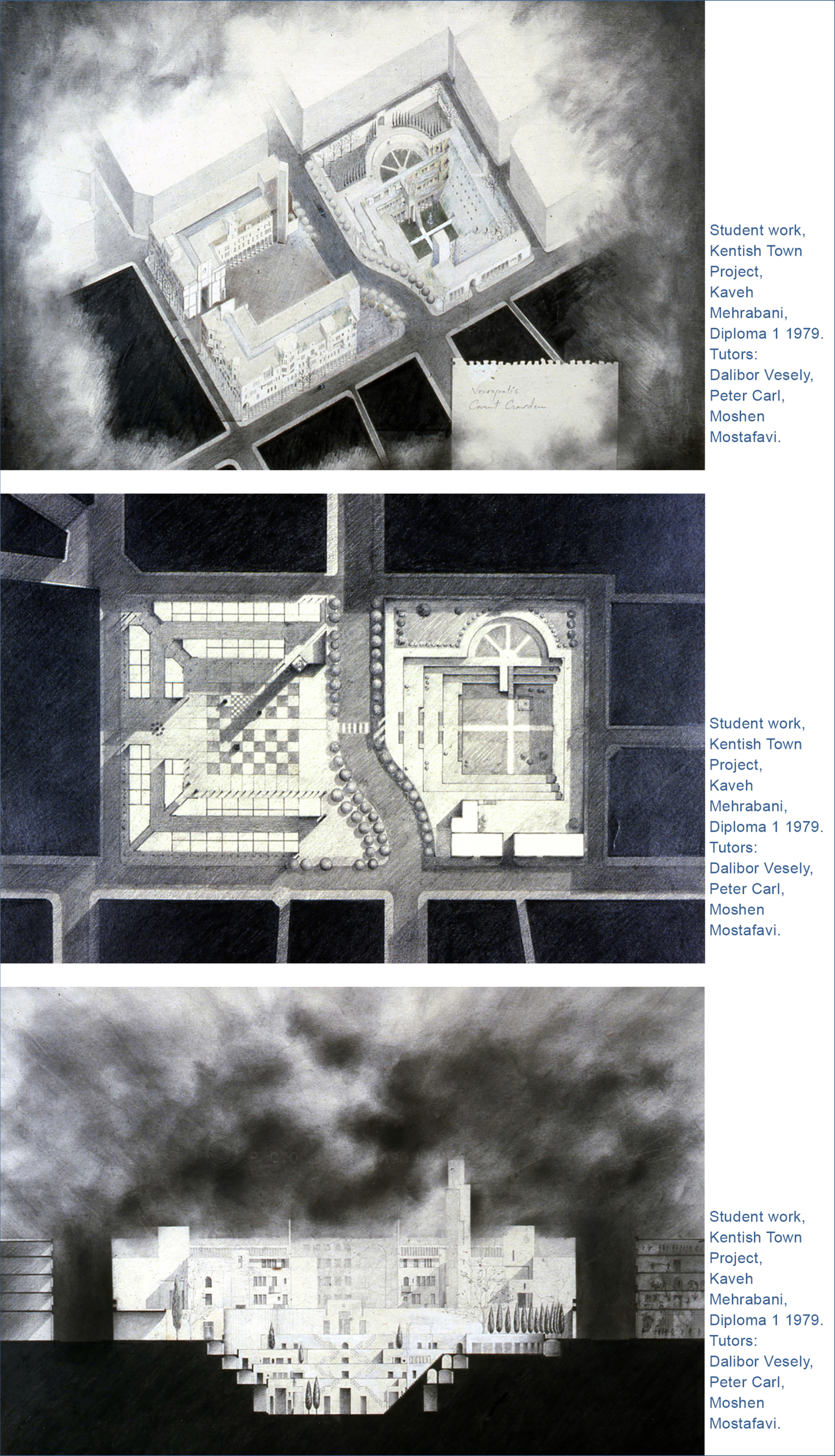
11 — Super modern AA tutors : Rem Koolhaas, Manhattan and Russian Revolution
Rem Koolhaas, AA Diploma 1972, AA tutor 1975-80, Pritzker Prize 2000, taught at the AA with one of the most relevant theories for modern architecture, focused on 2 directions: Manhattan, the most successful of 20th century mega cities, and Russian Revolution advant-garde art, the theory of art and architecture for a new humanity.
Manhattan is significant for 3 successes: unity of architecture development with uniform size city blocks; diversity of architecture with freedom within each city block; Manhattan as symbolic of 20th century human life success. With Manhattan, there is much to learn about 20th century modern architecture.
The 1917 Russian Revolution brought together artists from the Soviet Union in 1915-35, who were enthusiastic with the promise of a new human dawn, and who created new art and architecture to push the perceived human dawn. The most well-known ideas are Constructivist architecture, glorifying 20th century building materials of steel and concrete; and Suprematist art, glorifying 20th century pure geometry forms.
Rem Koolhaas identified the 2 directions as foundation to build new 20th and 21st century architecture.
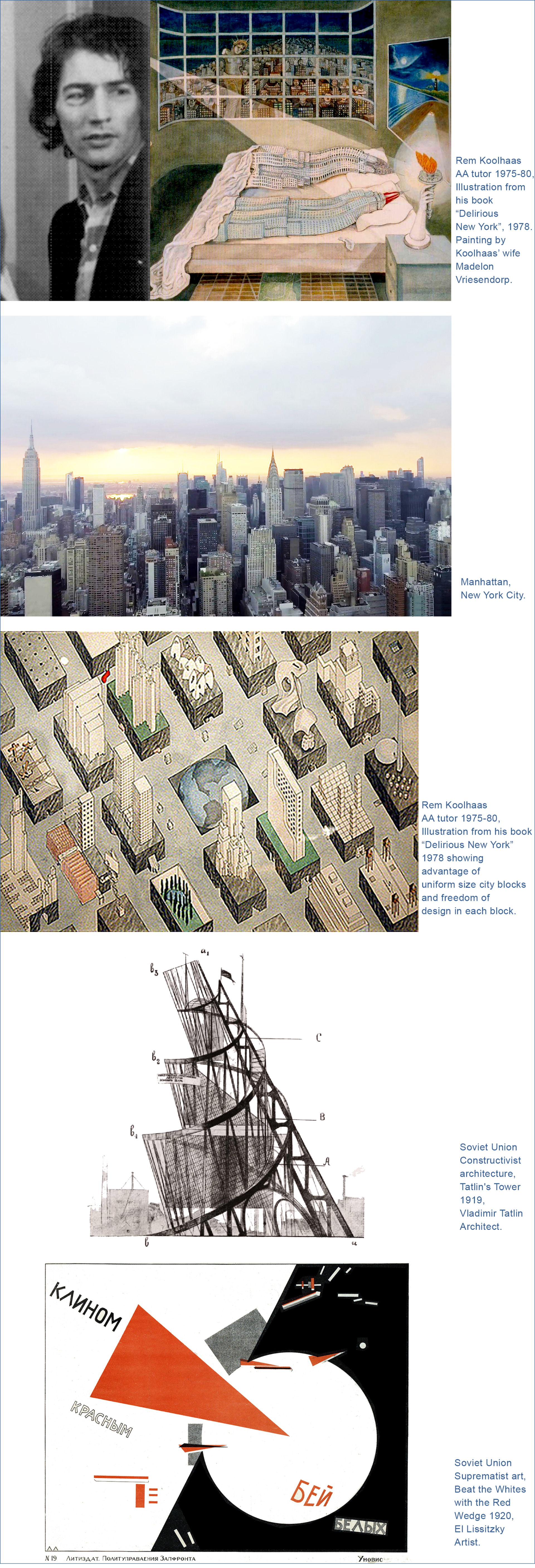
11 — Super modern AA tutors : Rem Koolhaas, Theory more successfully expressed by other AA-related architects
While the 2 focuses of Manhattan and Russian Revolution are important sources to develop modern architecture, we shall see that in putting theory to built architecture, other AA-related architects are more successful than Rem Koolhaas. In later architecture practice, Rem Koolhass tried to incorporate Manhattan and Russian Revolution elements in his design, but the relation is not convincing, his buildings seem more like his personal style.
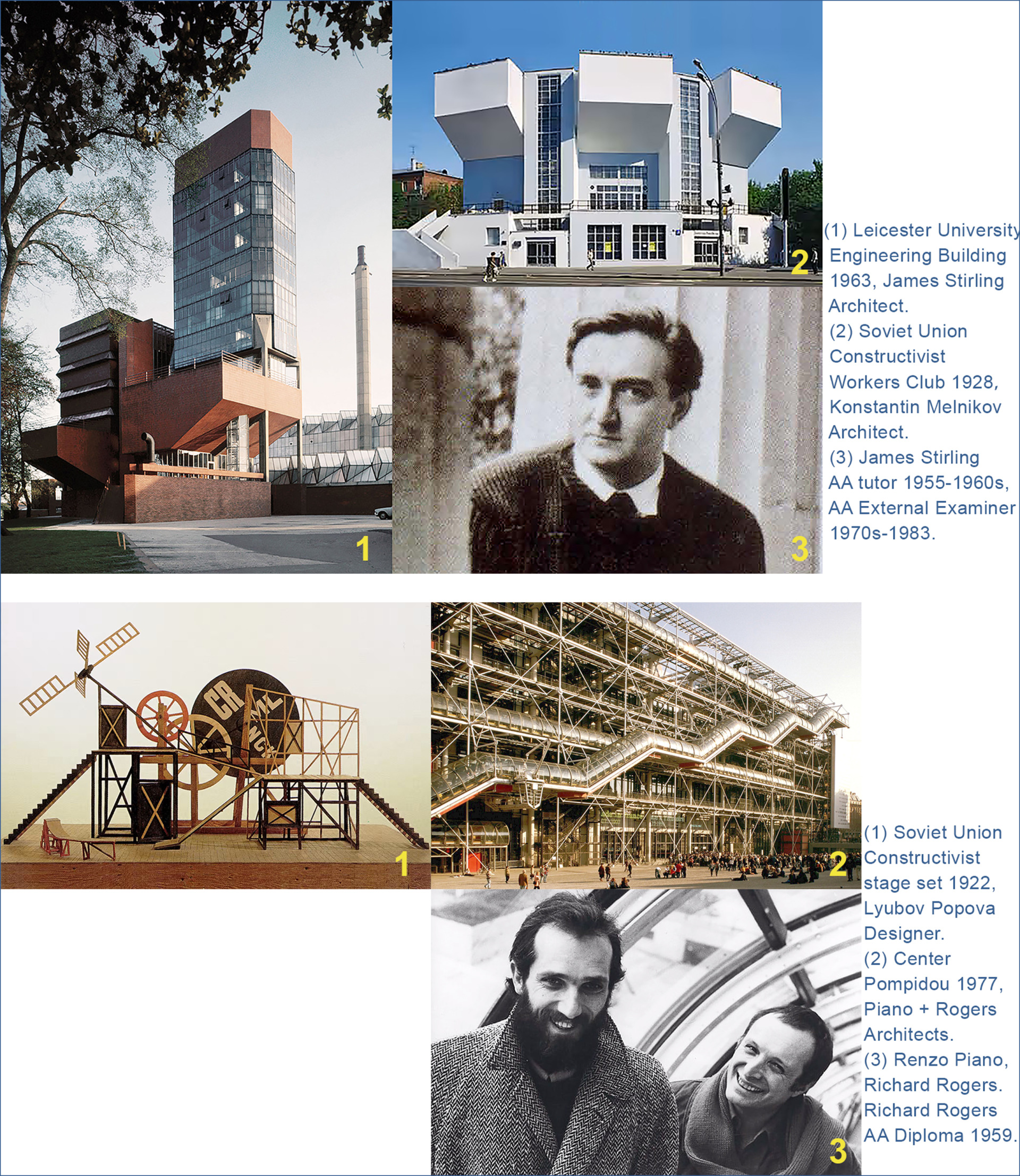
11 — Super modern AA tutors : Rem Koolhaas, OMA early projects
Rem Koolhaas formed the Office for Metropolitan Architecture, OMA, in 1975, when he began teaching at the AA, with painters Elia Zenghelis, Zoe Zenghelis and (Koolhaas’s wife) Madelon Vriesendorp.
Early OMA project drawings of 1970s and 1980s often contain 3 elements:
— the drawings were made as paintings, suggesting that architecture and art are overlaped. This was in fact a very AA thing;
— the drawings often contain hints of Russian Constructivism or Suprematism;
— the drawings often contain hints of skyscrapers and congested city, which are Manhattan characters.
In the 1982 OMA painting Boompjes Rotterdam, looking closely, a steel crane at the center of the drawing is in fact the Lenin Tribune monument designed by El Lissitzky in 1920. The building at the center of the drawing contains elements of Russian Constructivist architecture. That a building at the center of the drawing shows a good portion of the city of Rotterdam as backdrop, shows the architects’ concern of a whole city related to an individual building.
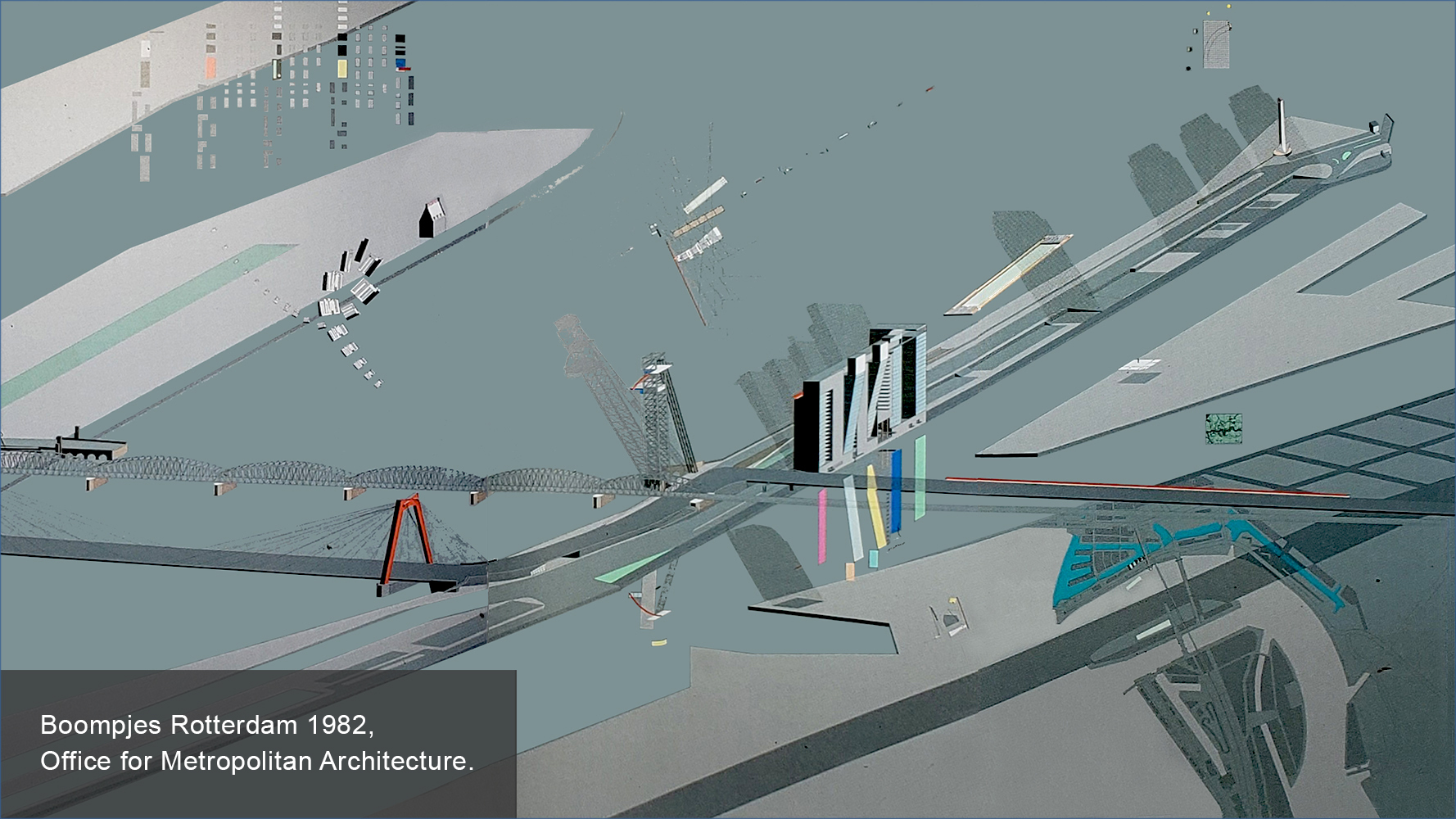
11 — Super modern AA tutors : Rem Koolhaas, OMA early projects
In the 1983 proposal for Parc de la Villette by the Office for Metropolitan Architecture, unless a viewer knows the background story, the viewer will not know that the strips of land on the park plan are in fact floors of a Manhattan-like skyscraper laid horizontally on the ground. In the black colored plan are dispersed bright color small squares, these meant bright colored kiosks dispersed in the park. In hidden meaning, the bright color kiosks dispersed throughout the Parc de la Villette are meant as “Suprematist Confetti” of the Soviet Union artists.
If built, these hidden meanings would be lost to an ignorant public.
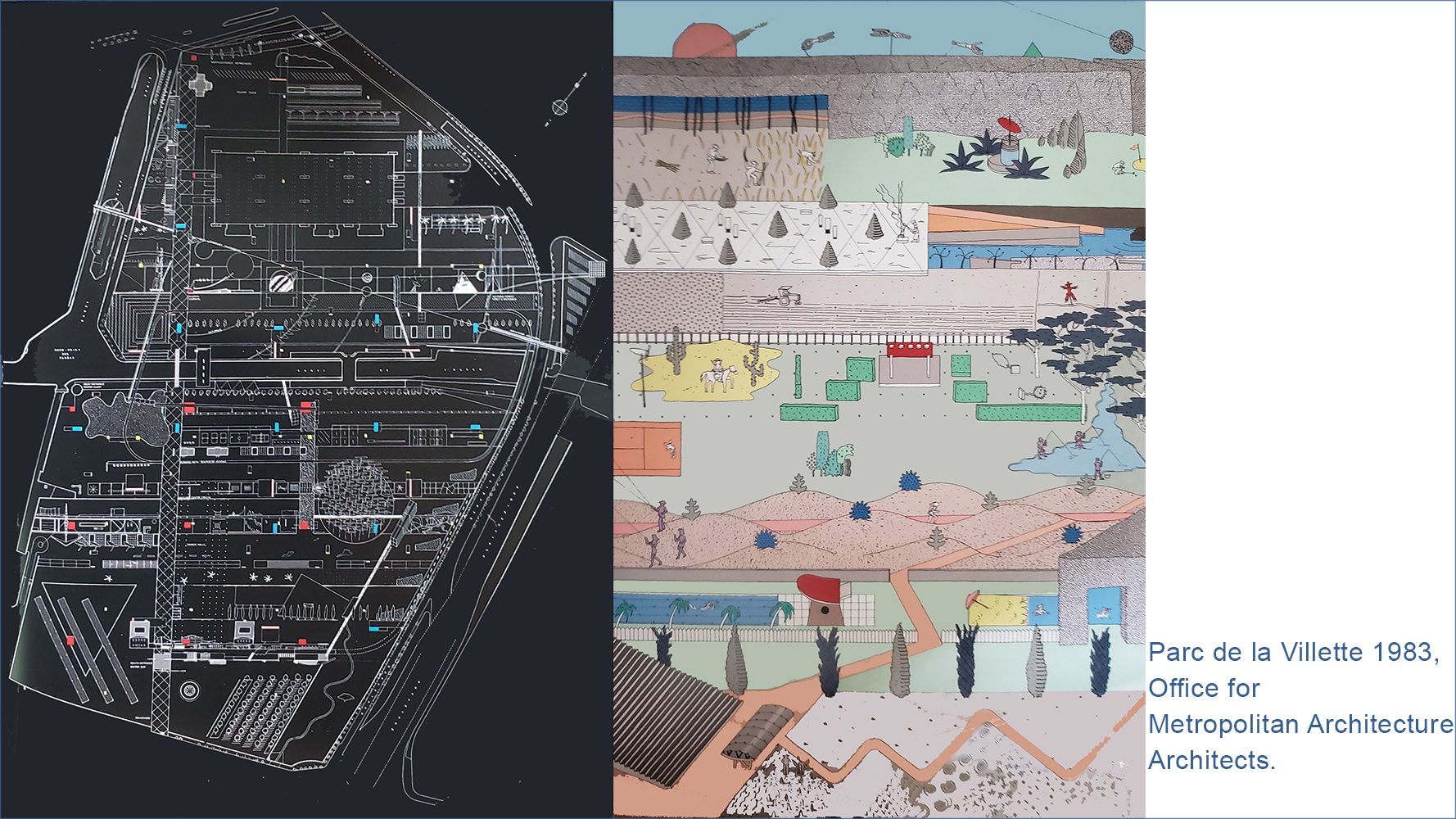
11 — Super modern AA tutors : Rem Koolhaas, Beijing and Manhattan
In the Beijing CCTV Headquarters by the Office for Metropolitan Architecture in 2002-2012, Beijing people saw a “giant wide spread pants”, which becomes the nickname of the building.
But Rem Koolhaas explained that the building is in fact 2 (Manhattan-like) skyscrapers, bent in the middle and meeting each other. It may be difficult for a viewer to see the “giant wide spread pants” as 2 bent skyscrapers.
More plausible, the building can be seen as a 21st century monumental portal, complete with 21st century imperfect society, that meekly challenges the Arc de Triomphe, Paris.
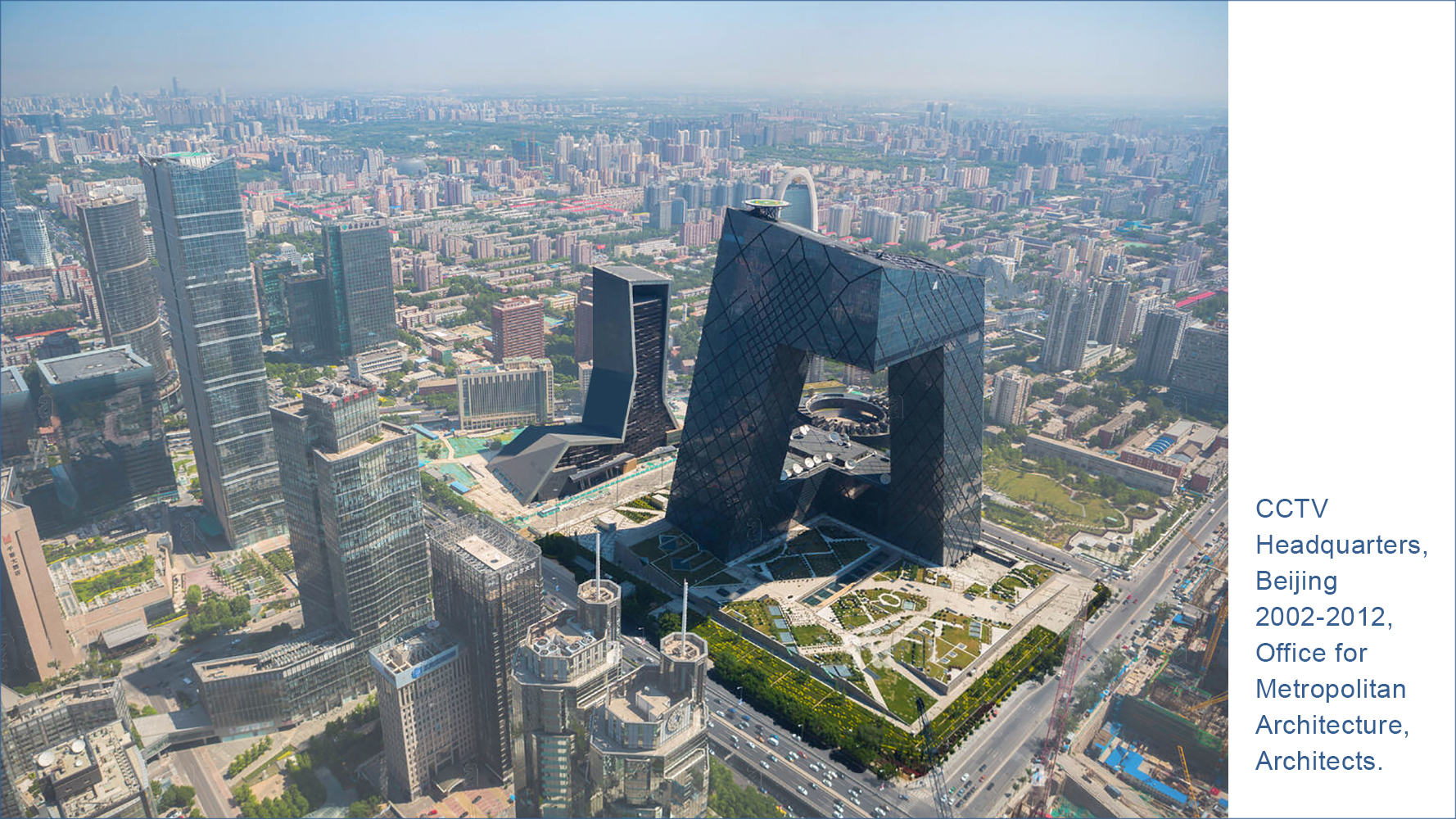
11 — Super modern AA tutors : Rem Koolhaas, Beijing and Manhattan
The 121 E 22nd residential building in Manhattan, 2016-2019, by the Office for Metropolitan Architecture, is special, because it was the first building in Manhattan realized by OMA, 38 years after Rem Koolhaas wrote his iconic book “Delirious New York” in 1978. The result building is hugely disappointing, indistinguishable from any anonymous building at any street corner in any city.
The building was not a design by Rem Koolhaas but by an OMA executive, but it was under Rem Koolhaas brand name. The building may be explained as loss of energy in Rem Koolhaas’ OMA.
The disappointment points to an important question linked to the AA School. It is that, between beautiful promises of AA students and tutors, and the real world of physical buildings, lies a great gulf that AA students and tutors lack ability to cross. The road from theory to practice always remains a gulf that AA students and tutors lack ability, often not even wish, to cross.
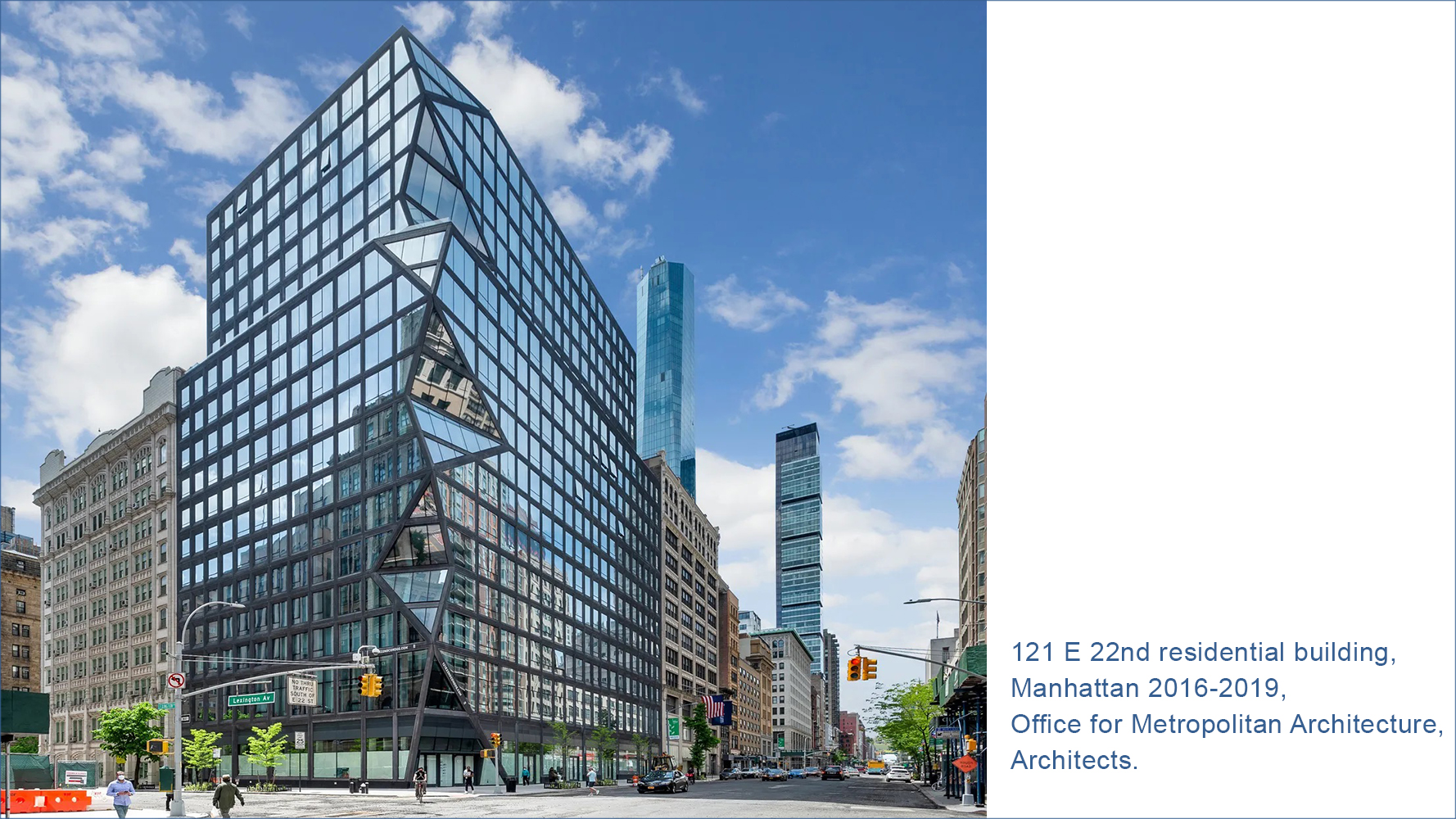
11 — Super modern AA tutors : Rem Koolhaas, Zaha Hadid
Through Rem Koolhaas’s service as AA tutor in 1975-1980, few documents show how successful his modern architecture ideas had influenced his AA students. One important exception was that in 1976-77, a 25 year old student from Iraq came to study under Koolhaas; her name was Zaha Hadid.
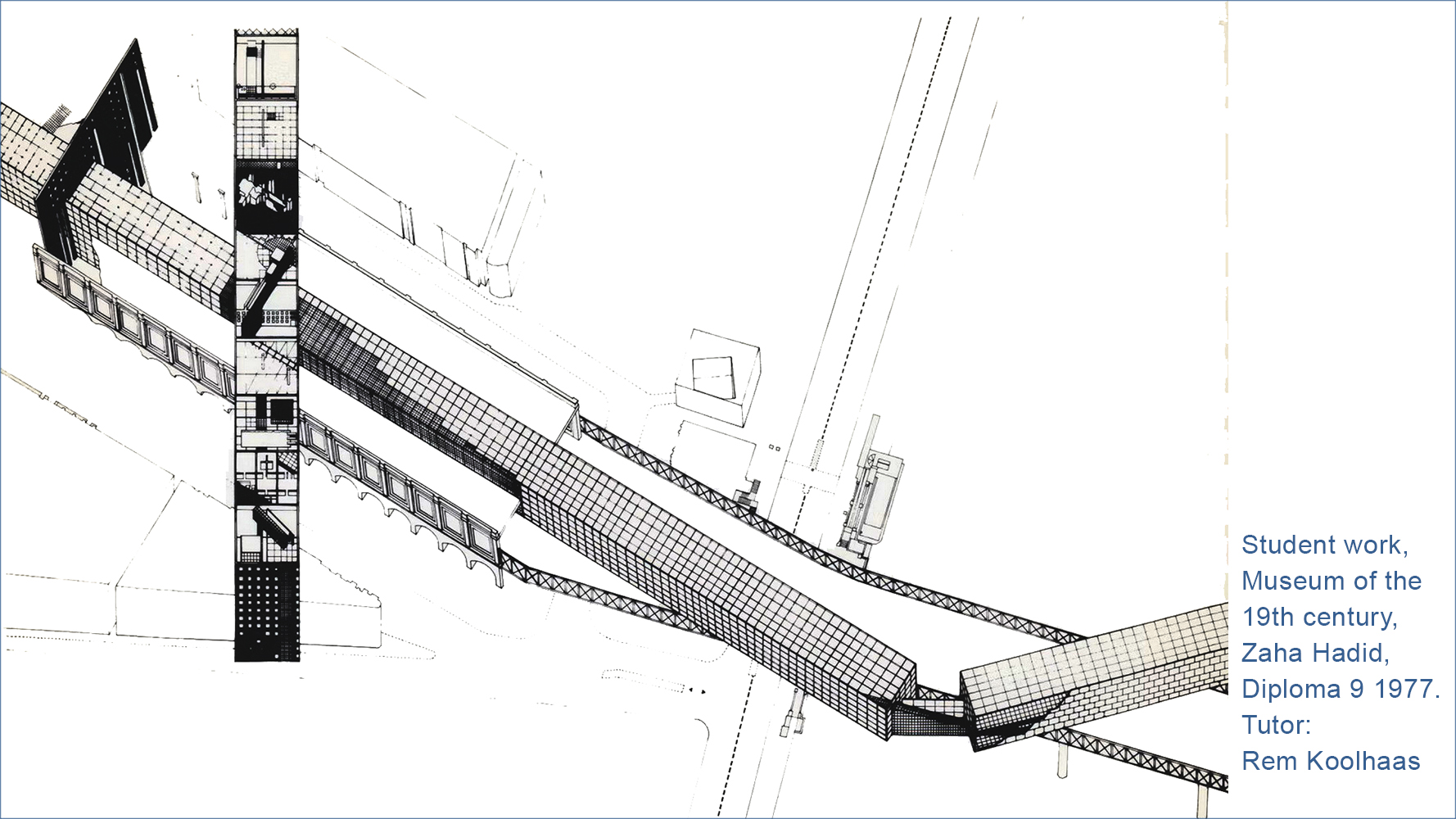
12 — One of the AA School : Zaha Hadid, her break-out one-two punch
Through Rem Koolhaas’s service as AA tutor in 1975-1980, few documents show how successful his modern architecture ideas had influenced his AA students. One important exception was that in 1976-77, a 25 year old student from Iraq came to study under Koolhaas; her name was Zaha Hadid.
Rem Koolhaas became AA tutor with 2 powerful arguments for a 20th and 21st century architecture: Manhattan, the city of modern humanity; 1915-1935 Soviet Union Constructivist architecture and Suprematist art movements that glorify a new humanity. Zaha Hadid, the student in Koolhaas’ class, took the Koolhaas suggestions seriously, she would take the Suprematist thesis seriously throughout her life.
In Koolhaas’ class project set for 1977, Museum of the 19th Century, if we compare Zaha Hadid’s design to Soviet Union Suprematist art, identical elements are immediately evident: freely located clean, sharp geometry shapes. What the student Hadid did, was to turn Suprematist art into a usable building, in doing so made her building among the coolest modern architecture, not only in 1977, but among the coolest modern architecture even today in 2023.
This project alone shot Zaha Hadid to deserved fame inside the AA School. But it is worthwhile to know that within the AA, Zaha Hadid was only one of many students and tutors of outstanding talent.
Many people know that Zaha Hadid’s architecture learning began long before she came to the AA School: when she was 11 years old she had made the decision she would become an architect. We need to know that in Hadid’s life-long hard work in architecture, it was her private strong will that always carried her forward.
It was Hadid’s private strong will that continued the success of her 1977 student project, into a one-two punch, the success of the 1983 Hong Kong Leisure Club design, and this one-two punch broke out Hadid into the international world.
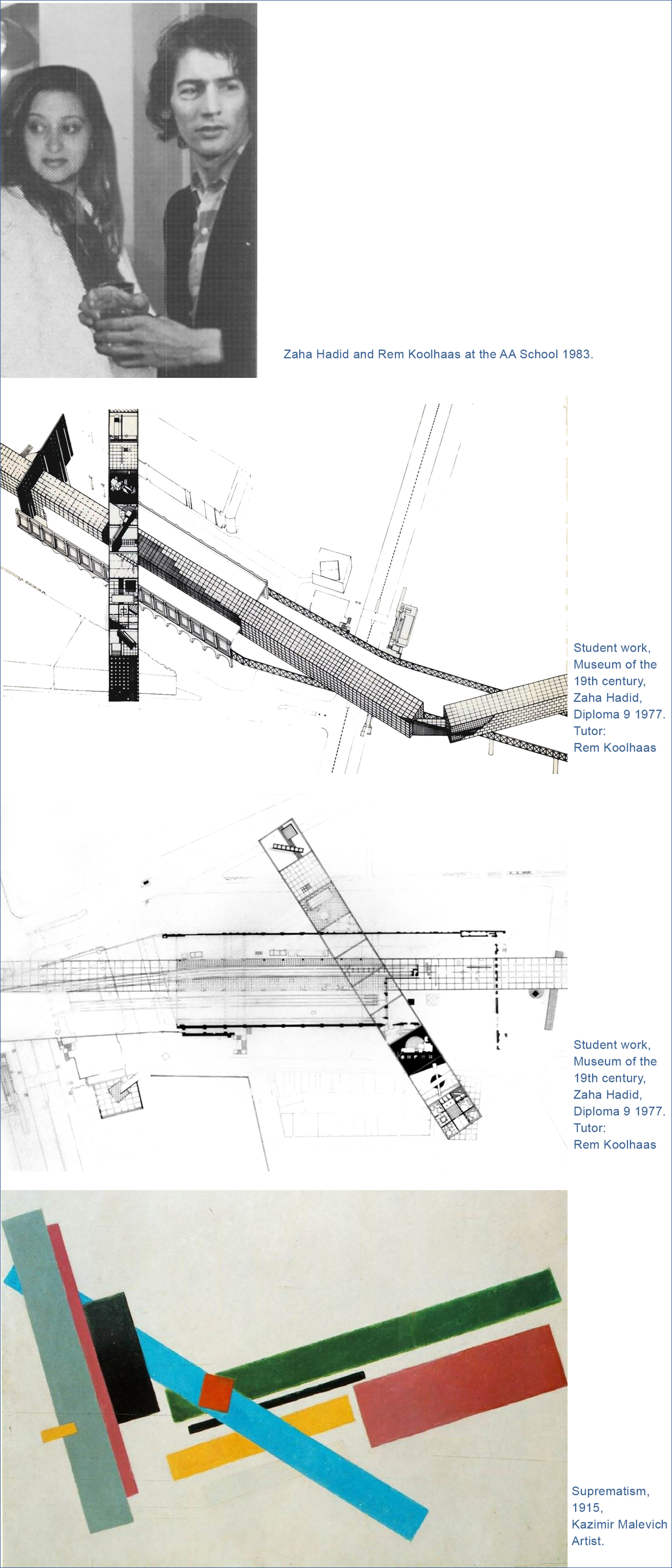
12 — One of the AA School : Zaha Hadid, her break-out one-two punch
In 1983 the news broke that Zaha Hadid had won an international competition, the Hong Kong Peak Leisure Club. A careful viewer will discover that Hadid’s Hong Kong Peak design is a Sequel to her 1977 student project, the Museum of the 19th Century: full reference to Soviet Union Suprematist art. Same as the Museum project, the Hong Kong Peak design if built, would be among the world’s coolest modern architecture for the 20th and 21st centuries.
The only difference between the Museum of the 19th Century and the Hong Kong Peak is, the Museum project was a student work only known inside the AA, but the Hong Kong Peak project was an international event. The 2 projects together became Hadid’s one-two punch, and broke out Hadid into the international world.
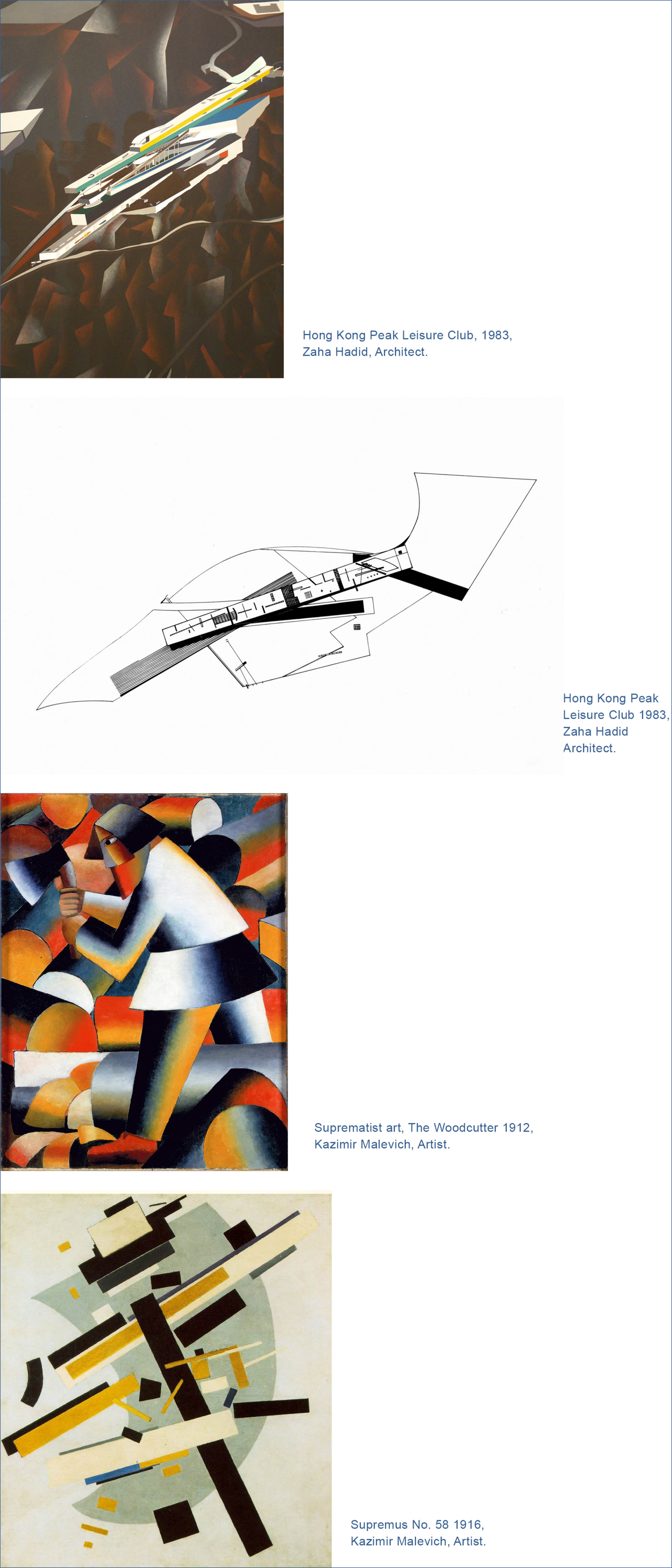
12 — One of the AA School : Zaha Hadid, Suprematism to the very end
Zaha Hadid’s subsequent life to contribute to the international world was not easy. Her ability to design buildings fell into, or became lost in, a one-dimension tract of spherical buildings, regardless of any environment.
Perhaps few people realize, that Zaha Hadid was a sincere person, faithful in devotion to 2 ideals she learned at the AA School: devoted to architecture, and devoted to 1910s Soviet Revolution Suprematist ideal, glorifying a “new” humanity.
The “new” humanity cannot come from philosophy, coercive government, or coercive buildings, it is more complex. Perhaps it would have been a question Hadid asked herself, looking back at her life-long hard work.
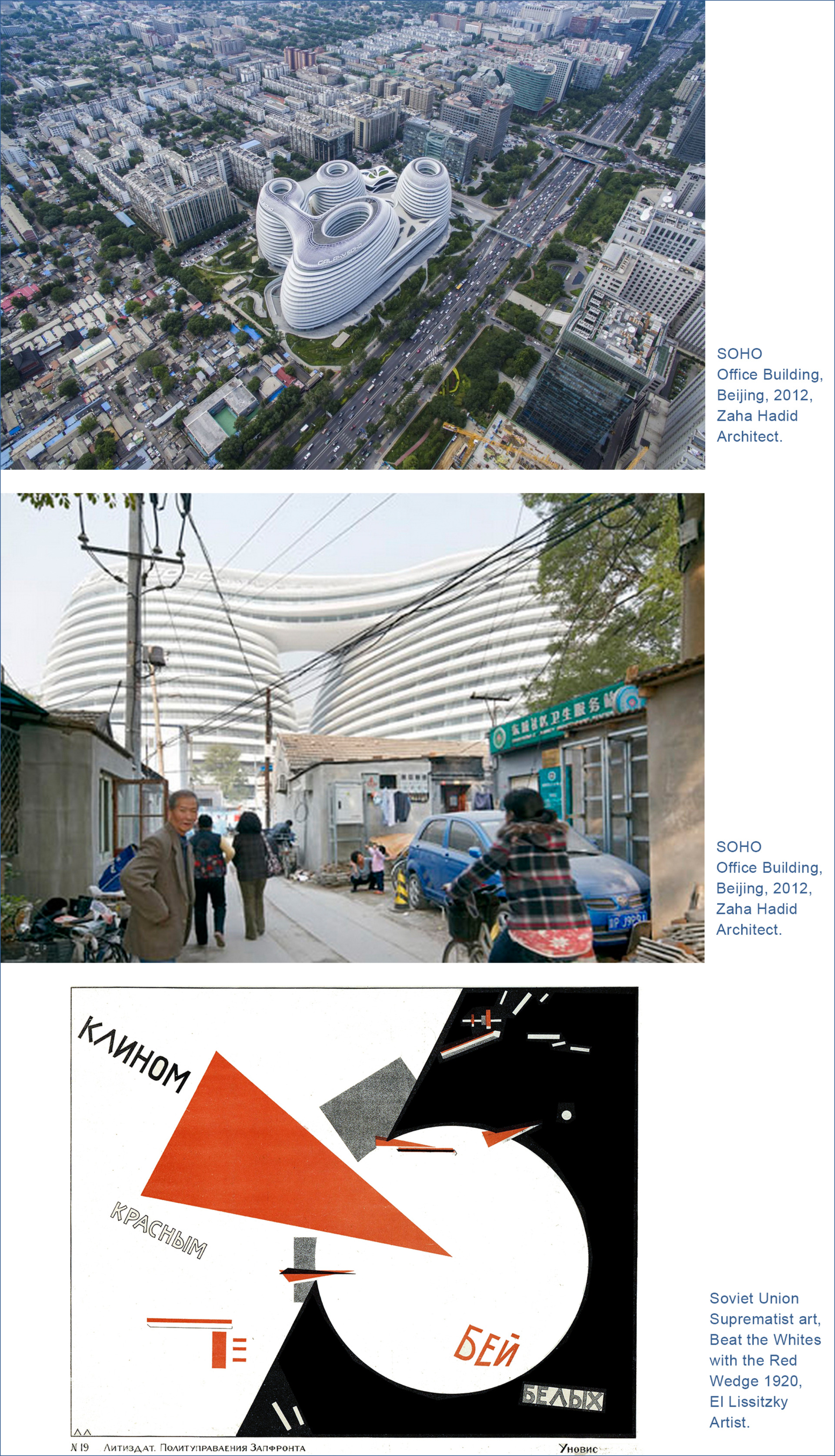
12 — One of the AA School : Zaha Hadid
The first time I saw Zaha Hadid, I was in Alvin Boyarsky’s office concerning my class allocation. Boyarsky thought one tutor could help, and he asked Zaha to come to his office.
When Zaha came in, from Boyarsky’s simple “How are you Zaha?” to Zaha, it was plain that Boyarsky respected her, and loved her.
Zaha Hadid was then one of the stars inside the AA School, being stars known for their outstanding design work. But Zaha was just one among numerous in the AA, for outstanding design work.
That year Zaha held an exhibition of her design work in the AA. A memory remains with me deeply: at a stair landing, there was a flag pole, with a large canvas flag, of an explosive architectural plan which Zaha painted. It was the only time some person shows that architecture plans can be hung as a flag.
Over the years I learned of Zaha’s advance on the world stage, her first attempt in Germany for a fire station, then numerous buildings in China. Architecture work is back-breaking for any architect, Zaha must have paid with merciless hard work, until she gave her life for architecture.
The AA School is not in position to revolutionize classic humanity architecture, with good reasons. The AA Chairman Alvin Boyarsky did not mean that the AA disrespects classic humanity architecture. He meant meaningful debate and widening of awareness. Debate it is with Zaha Hadid’s work, and AA School’s work.
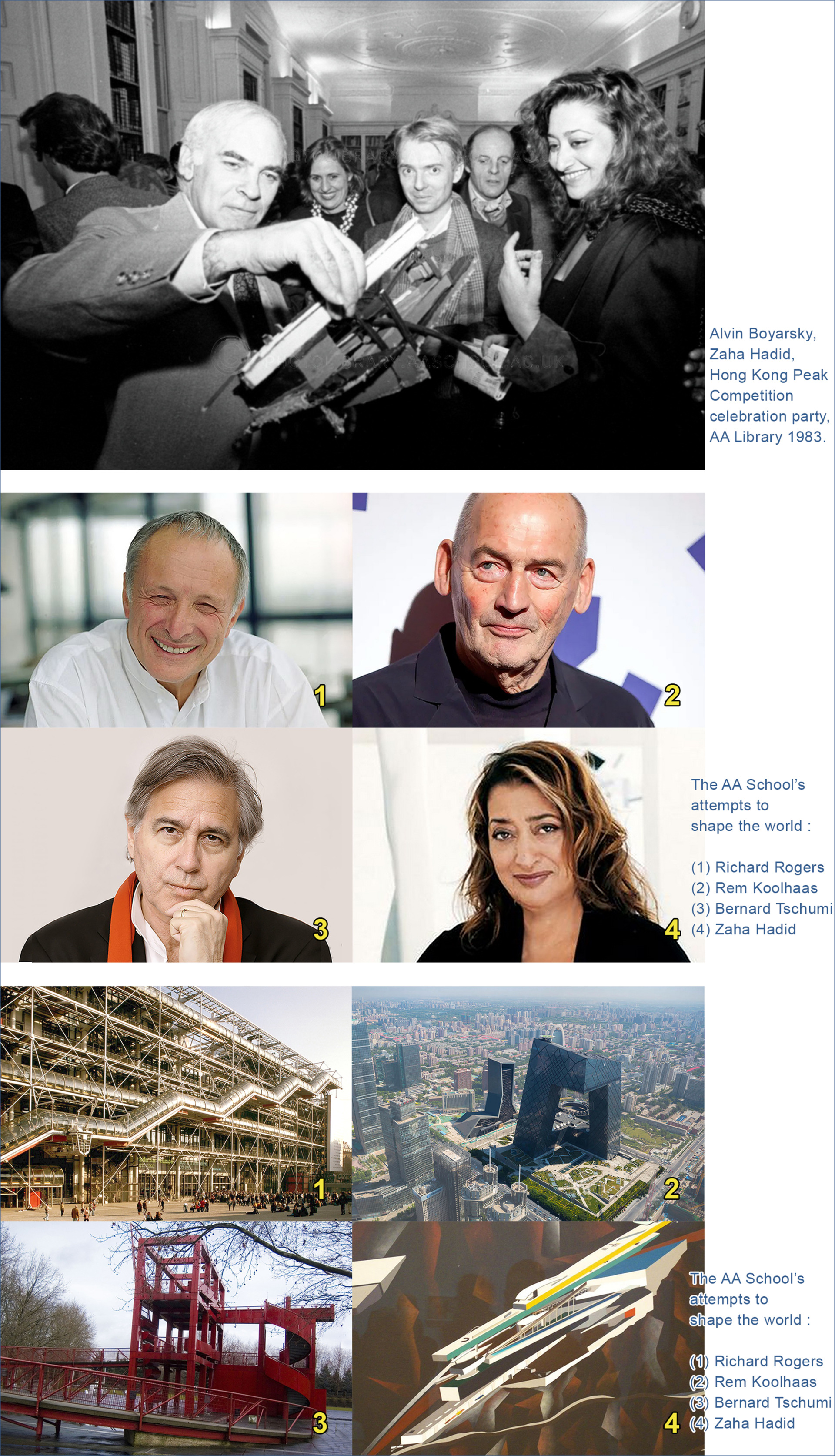
11 — Super modern AA tutors: Bernard Tschumi
For cutting-edge modern architecture, the AA served a rich compost. This was the Chairman Alvin Boyarsky’s own description, it was accurate.
Bernard Tschumi, Swiss Federal Institute of Technology (ETH) graduate 1969, AA tutor 1970-1979, brought to the AA an analysis of architecture that once more shocked the AA, and which eventually grabbed international world attention.
Tschumi received influence from his parents, a Swiss architect father and French mother, architecture education from an elite school ETH, and French intellectual life in 1960s Paris.
We may consider Tschumi’s architecture idea formation from 3 sources. In 1968 students in Paris erupted in demonstrations and riot for their intellectual ideas. This left a mark on Tschumi who was the same age as the Paris students.
Secondly, in 1970 Tschumi came to London and became AA tutor. London then was at the end of the “Swinging London” era, a pleasure indulgence youth movement just as profound but opposite to the Paris student intellectual riot movement.
Thirdly, related to French intellectual exploration, Tschumi as AA tutor became interested in how human subconsciousness may help form architecture design.
In Tschumi’s AA teaching and eventual architecture design on world stage, we may see all the above traces: rebels like the 1968 Paris students, pleasure indulging like London youths, mystical like the human subconscious. In his AA class, Bernard Tschumi asked of his students a dauntingly difficult task, to bring the traces together, and form an architecture.
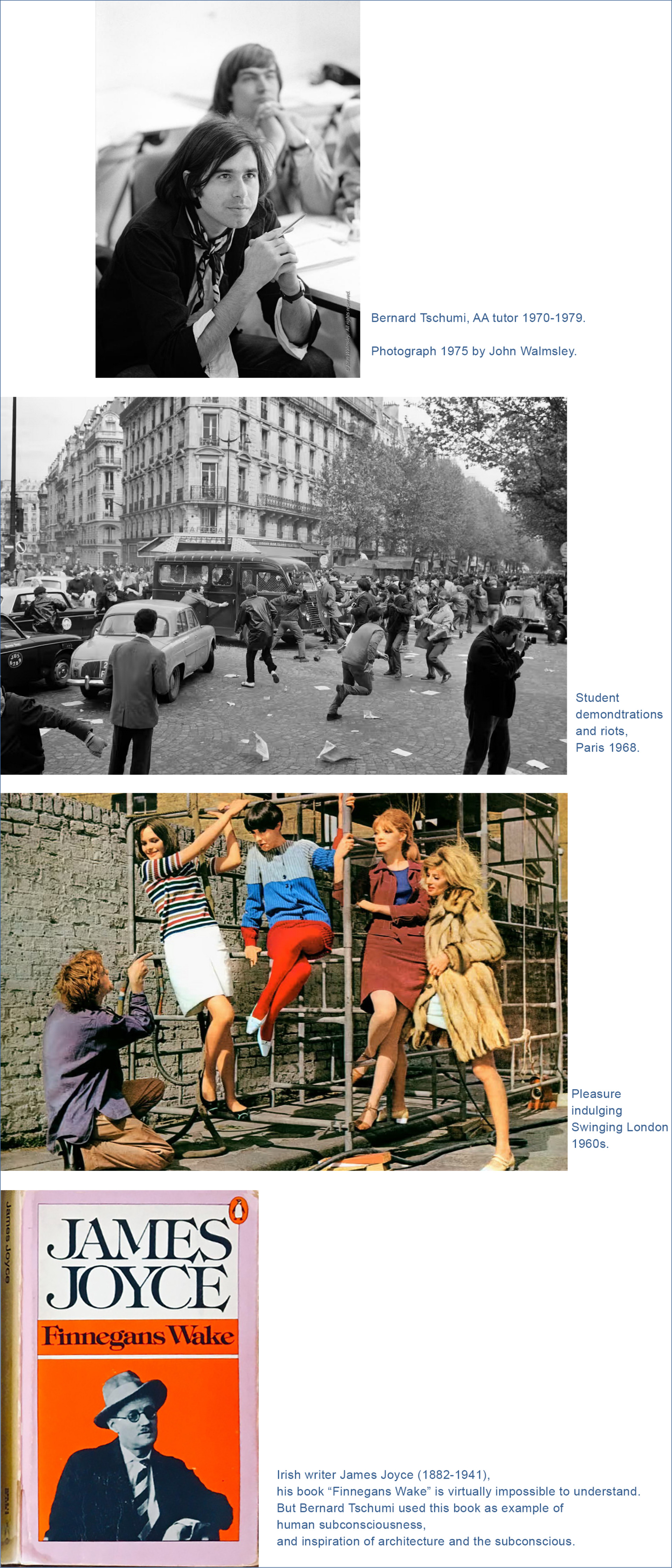
11 — Super modern AA tutors: Bernard Tschumi
One may suspect that, with a background of 1960s French student revolt, London youth hedonism, and French intellectualism as support, the intellectual himself Bernard Tschumi would channel these resources into some definite architecture program. This happened as 2 directions.
The 2 directions start off unrelated. One direction is a hard look at the established architecture world. The other direction is looking at how the human subconscious may help shape architecture.
Through his lifelong work, he carried his ideas through from beginning conception to the end, in directing his students to participate in his ideas, to his own writings and drawings on criticism of the established architecture world, and about the human subconscious, and eventually putting his ideas through built projects.
On a hard look at the established architecture world, his writings in the form of long articles are rhetorical. But he also shortened his message as concise posters. Thus came his well-known “Advertisements for architecture”.

11 — Super modern AA tutors: Bernard Tschumi
The Irish writer James Joyce’s book Finnegans Wake (1939) is a novel-like book that blends the reality of life with dream worlds. Attempting to blend reality architecture with the human subconscious, Bernard Tschumi set for his AA students in 1976 a project, “Joyce’s Garden”, using Finnegans Wake as example, to design dream worlds in specific locations in London.
Tschumi himself participated in the project; his version of Joyce’s Garden is a blend of hard-line drawings and dream-like architecture. In 1976-1981, he continued the exploration of subconscious dream in his project Manhattan Transcripts, attempting to blend New York City city spaces with human behavior not related to the space, but happening in the space.
Tschumi’s architecture explorations are similar to James Joyce’s writings in many ways. They are experimental, unbound by established conventions, advant-garde, difficult to comprehend by the public. But it is so very AA School.
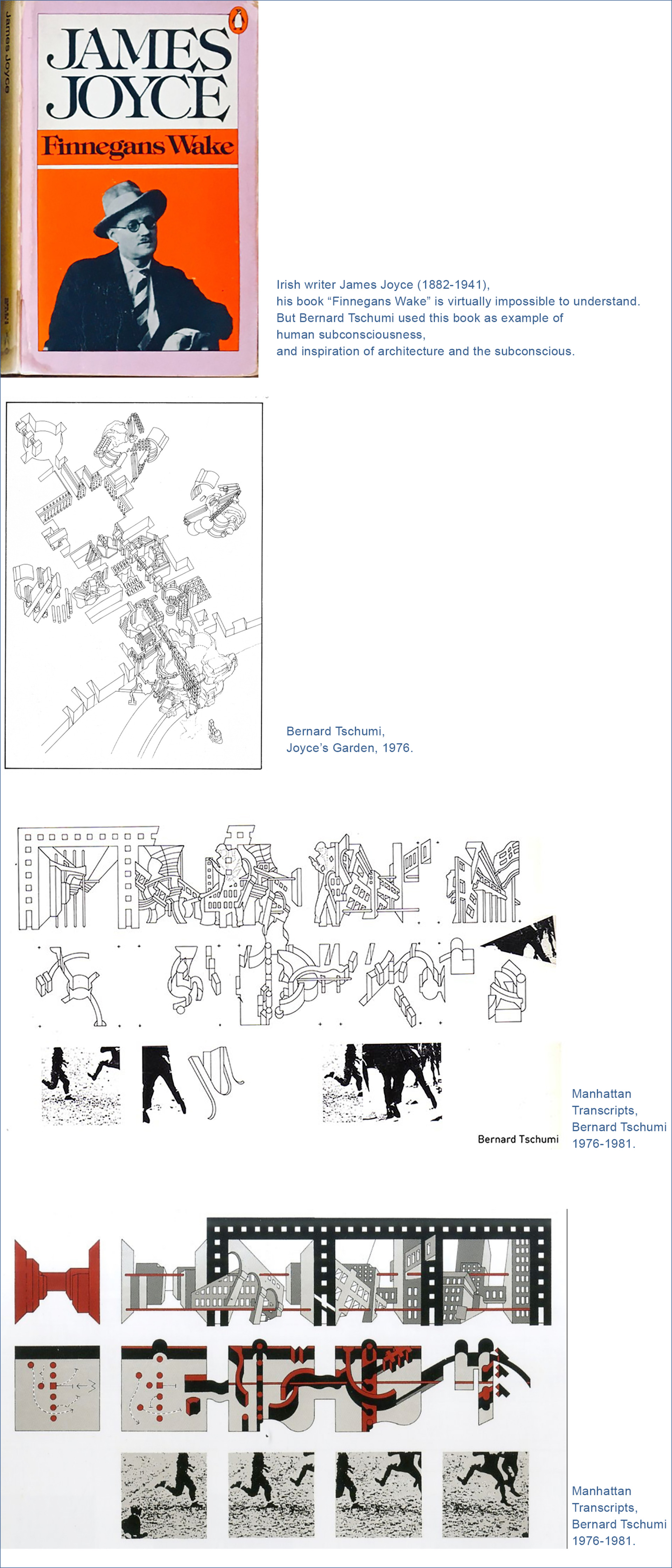
11 — Super modern AA tutors: Bernard Tschumi
Pushing architecture thinking against established conventions, Tschumi produced different communication formats, all of them suggesting confrontations in modern life — advertisements for architecture, architecture of the subconscious, hard critical writings.
In one project Tschumi set for his AA students, impossible uses were imposed on city sites, to illustrate conflict in modern city life.
For a ballroom put into a London church, student Tony Summers planted a church spire on top of London redlight district sex show cubicles.
On plan, the “ballroom” is a bank of narrow corridors — which Soho London cramped buildings are — suggesting sexual unions while dancing through the corridors, leading to back gardens (climax?).
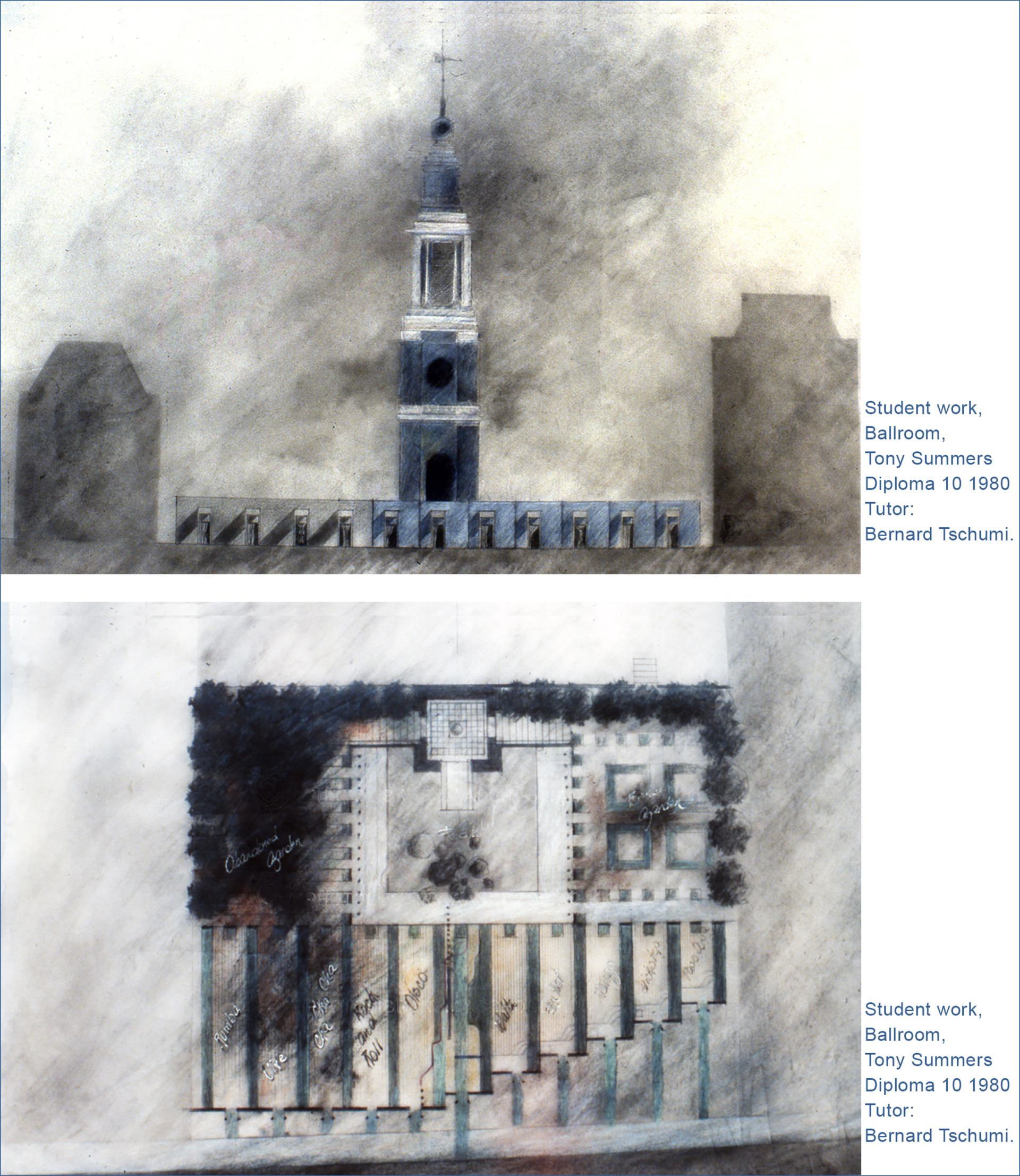
11 — Super modern AA tutors: Bernard Tschumi
In 1983 Bernard Tschumi won the competition to design Parc de la Villette, Paris, the first chance to put his ideas to real buildings. There are some ideological intellectuals who do argue, for an intellectual architect, perhaps physical buildings are just one expression of the mind, perhaps no more important than other expressions for example drawings and writings. But for real human society they are not the same. People in real society have to use the buildings; buildings are ultimately for people in real society.
A careful viewer will find that Parc de la Villette installations built to Tschumi’s design is a faithful sequel to his exploration work at the AA School in 1976: exploration of the human subconscious in literature and architecture, exploration of 1920s Soviet Union advant-garde. But to common people visiting Parc de la Villette, the intention of the installations would be difficult to comprehend.
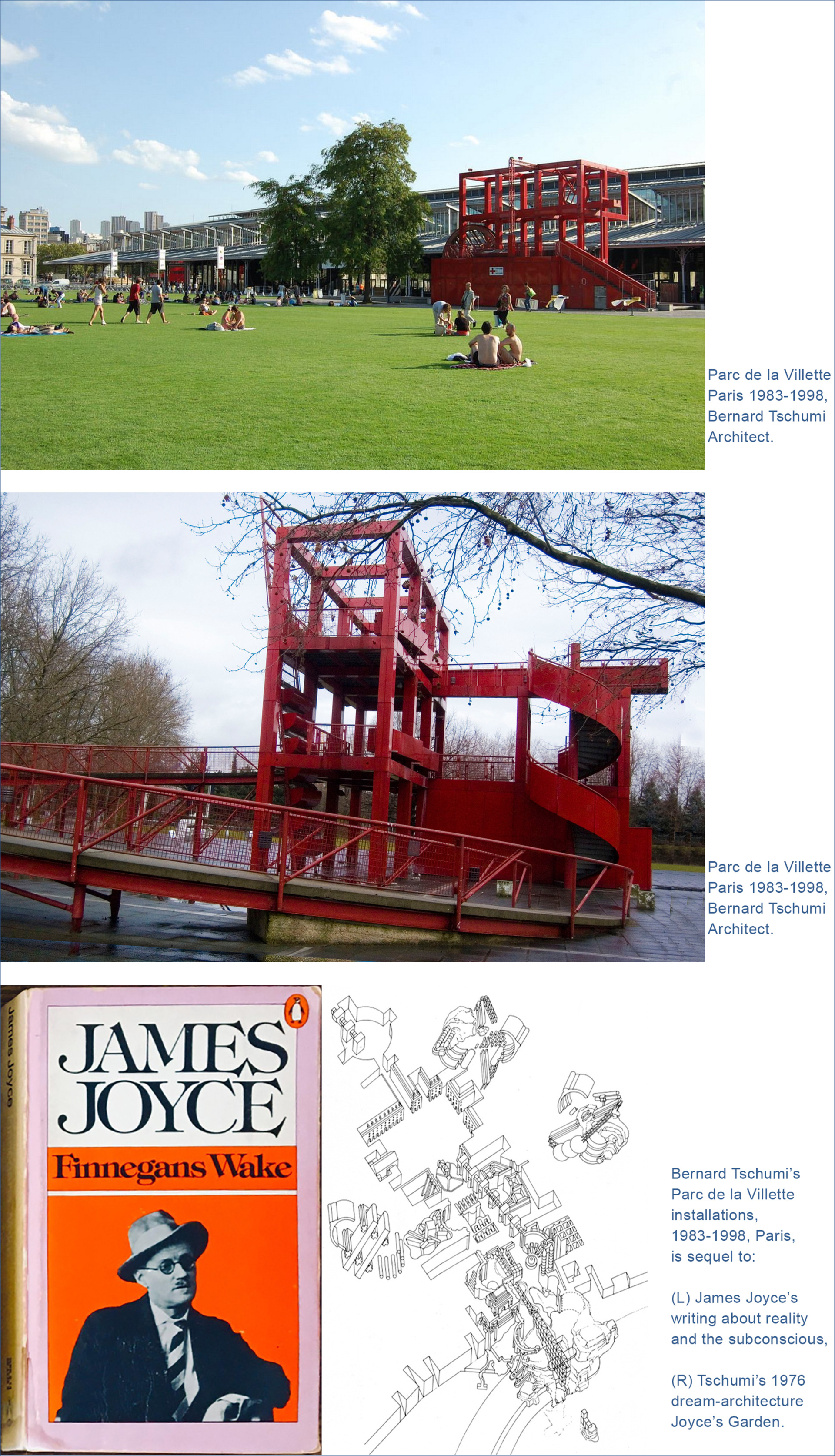
11 — Super modern AA tutors: Bernard Tschumi
Modern century society finds the Irish writer James Joyce strangely fascinating, that he represents a difficult attempt to modernize art.
I think Bernard Tschumi, AA tutor 1970-1979, Dean of Columbia University Graduate School of Architecture 1988-2003, was equally fascinated by James Joyce, and he emulates Joyce in architecture. Like Joyce, Tschumi’s lifetime work succeeded in creating 2 edges: his architecture has a modern edge, and it permanently exhibits an aloof edge aloof from easy common society.
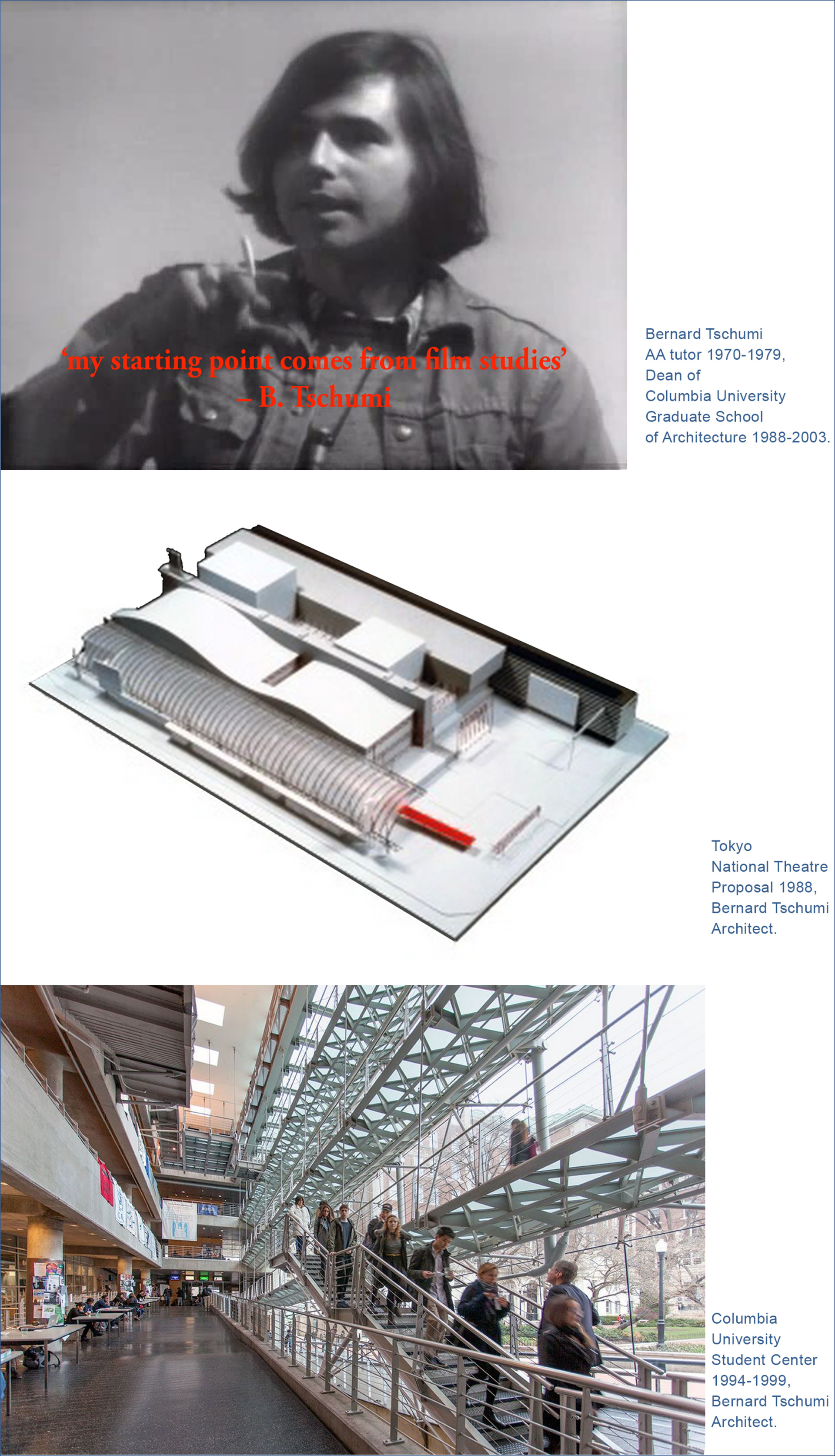
11 — Super modern AA tutors: Nigel Coates
At the same time of AA tutor Rem Koolhaas, championing Manhattan, Constructivism and Suprematism as inspirations for modern architecture, and Bernard Tschumi looking for fresh architecture from critical analysis and investigation of the subconscious, came Nigel Coates, AA student 1972-1974, AA tutor 1977-1988. Nigel Coates grew up in a picturesque Mid-England town with middle class parents, studied in conventional schools, but when he came to London and enrolled at the AA he joined the avant-garde AA circle.
The thesis developed by Nigel Coates revolves around how English people, particularly the working class, really live.
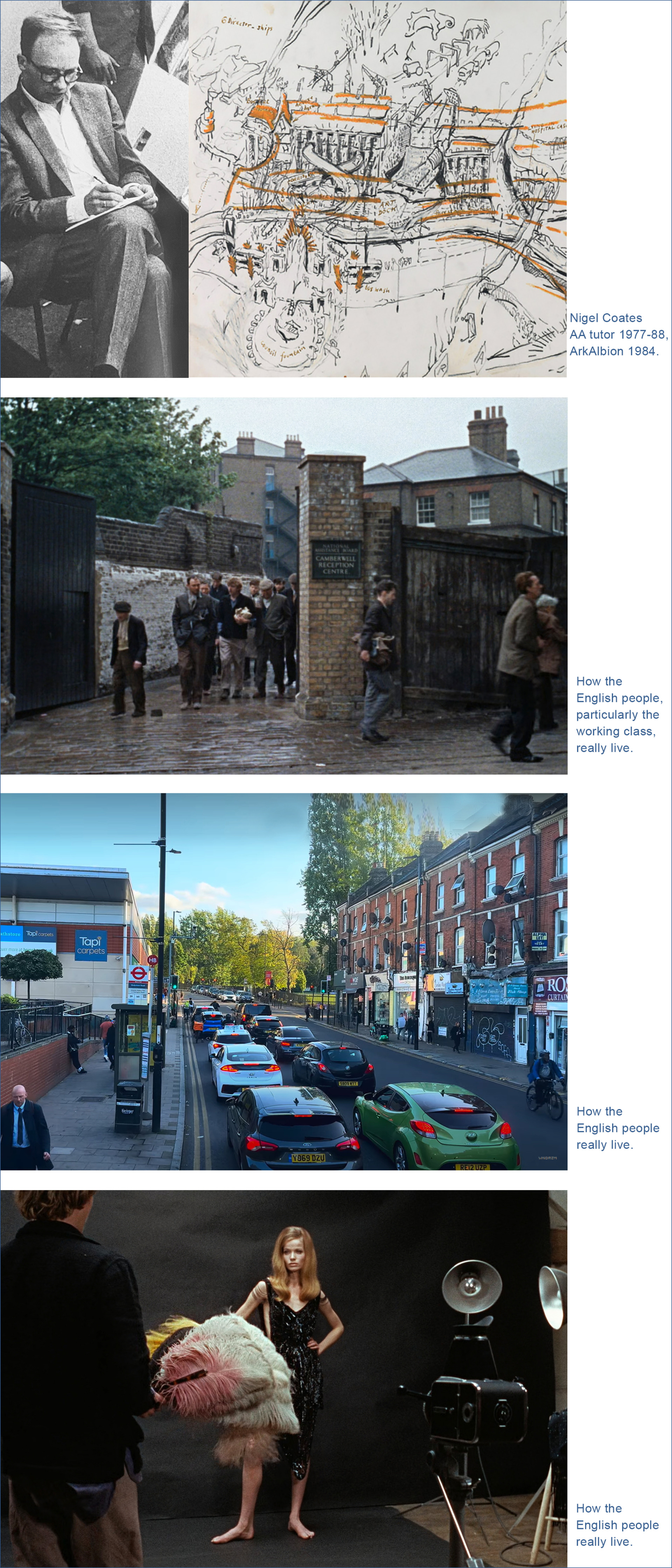
11 — Super modern AA tutors: Nigel Coates
Nigel Coates, as an AA tutor and hopping between America and Italy avant-garde circles, in 1981 had a flash of insight: “I had a flash of insight into how to draw architecture in a way that channeled the sensation of motion.” The same year he asked his AA students to work out designs for the Isle of Dogs in run-down East London (now a wealthy bankers’ district), Coates himself participated in design, using his flash-of-insight drawing technique. The result exploded into a new drawing revolution at the AA. In years to come the Nigel Coates way of looking at London became an AA delirium, and led to the battle between James Stirling, the 20th century icon architect, and the punk AA School.
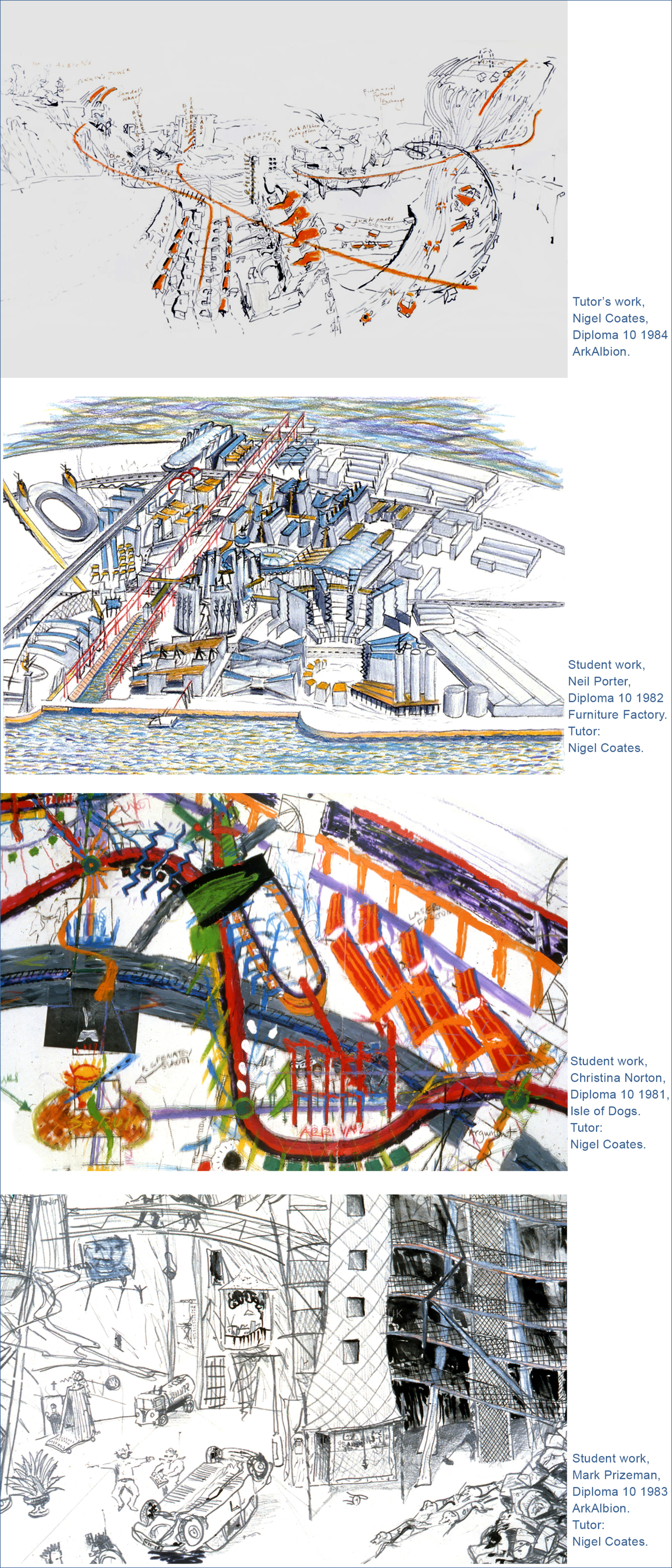
11 — Super modern AA tutors: Nigel Coates
AA Diploma 10 under Bernard Tschumi in 1970-1979 and Nigel Coates in 1977-1988, was for years encouraged to be rebellious. Unhinged attitudes of AA Diploma 10 students became AA tradition, and all came to final clash in a great debate about architecture in 1983. In the year-end work review, James Stirling, 20th century icon architect and AA Examiner, examined the Diploma 10 work and debated against the AA School to midnight. Stirling’s judgement on all Diploma 10 students work were, they were “unjudgeable as architecture”, they were “bunch of cartoons”, they did not qualify as architecture. Alvin Boyarsky, the AA Chairman, replaced Stirling with Bernard Tschumi, himself former Diploma 10 tutor. Tschumi passed all Diploma 10 students.
James Stirling’s final words were, if this was AA School attitude, he would resign as AA Examiner. Peter Cook, himself AA icon tutor, and friend of both Stirling and Boyarsky, recalled, “It was some years before Stirling would come back into the building.”
The rebel movement in the AA School had come to a head, about how far being a rebel can go until it is meaningless to humanity.
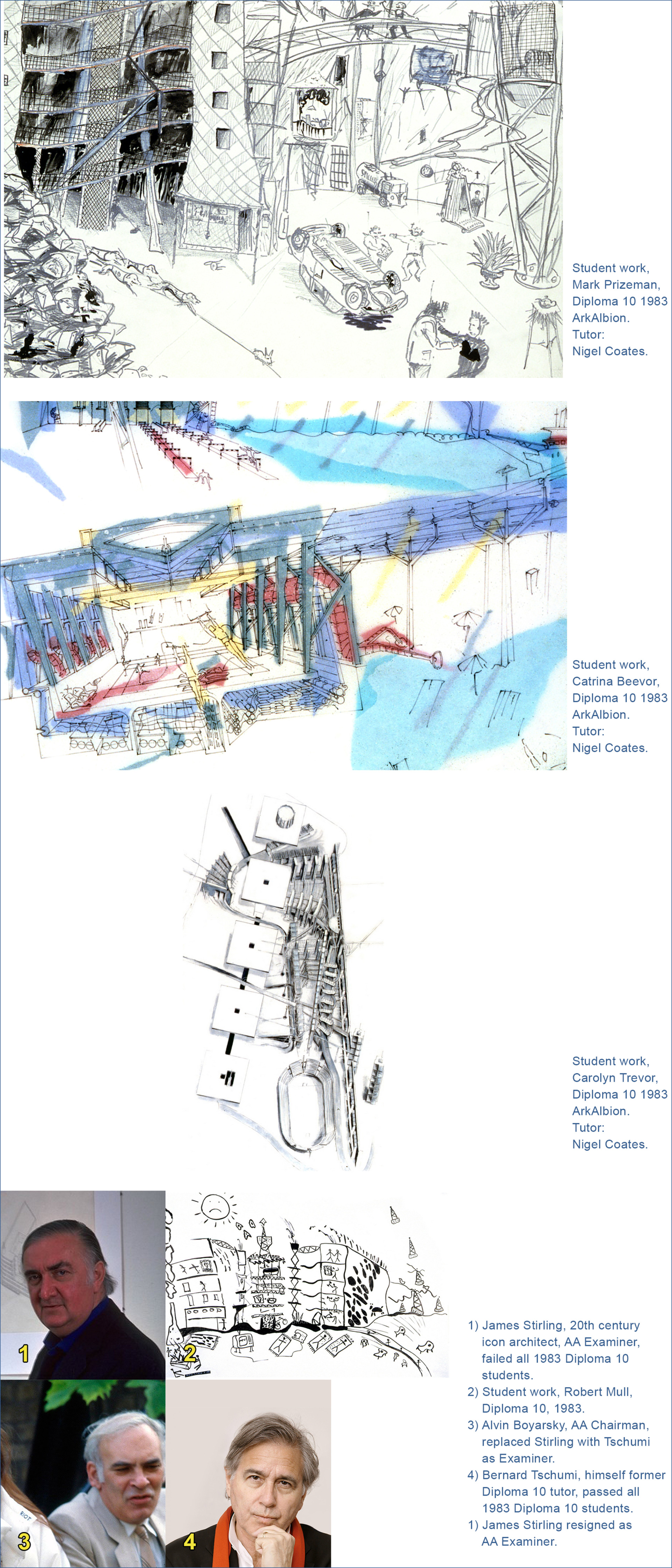
13 — The Rain Maker and The Rain
“I was not sure if I wanted this job. So I told them a story. A town was without rain for a long time, and the townspeople prayed for rain. The town found a rain maker, the rain maker came, he asked for generous money payment. He got the money, got the women, then he climbed on his horse to leave town. The townspeople in frustration asked him, where is the rain? The rain maker replied, the rain won’t come until 24 hours after I leave town.
In 1970 I was doing well with my own work, the International Institute of Design. But I came here, the AA, instead.”
Thus in 1983 Alvin Boyarsky recalled his 1970 interview by the AA, when the AA was close to closing the school. The rain maker, Boyarsky, did not leave town, but gave the AA School new international fame, in fact gave his whole life to the school, until his death in 1990.
In Peter Cook’s words, “he spent 14 hours a day ‘living’ the AA . . . he sniffed out talent, interrogated, he hustled.”
But did the rain come? That is, did the AA School succeed in giving worthwhile architecture to the world?
An AA student in 1981, Jeremie Frank, designed a machine, to be 20 stories tall, that would capture and convert sound waves to energy. Jeremie Frank was so much a classic AA student, never conventional, fresh, and shocking. Typical of a gifted AA student, she sailed through the navigation of tough architecture intrigues, and outside of school played guitar in a music band.
Jeremie never became an architect in the outside world, and did not produce architecture worthy for the humanity world. She worked for local arts communities, worked as disc jockey, worked in radio shows. This is, really sadly, typical of so many AA students, dazzling star while AA student, and in the long years after leaving the AA, the shining star just faded.
We may say that, while nurtured by the AA School to rebel against conventional human society, after leaving school and facing the wide conventional society, so many AA young stars could not fight the battle as a lone individual, or lost energy.
Stars like Rem Koolhaas and Zaha Hadid struggled against the conventional human world outside. Rem Koolhaas became conventional himself and bland. Zaha Hadid, despite worldwide fame, only produced spherical-form buildings without worthy meaning.
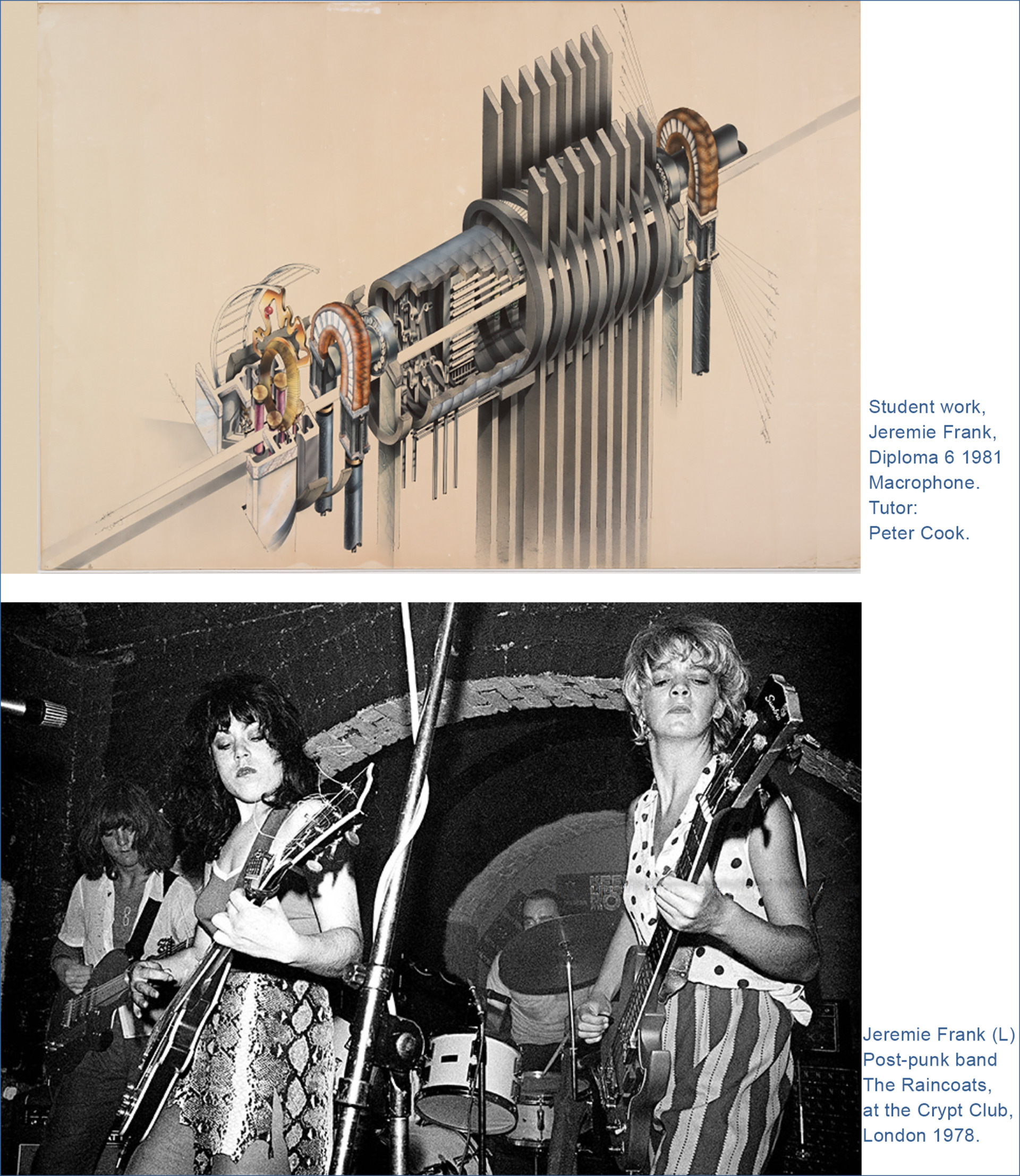
13 — The Rain Maker and The Rain
Many students could not pass the merciless AA School requirements. A small elite number of students found the way for some original ideas, to earn the respect of the school, and even these may ultimately not pass the true test in world society, of world people badly needing useful, good architecture.
In the great filter of aspiring architects failing to pass, one or two managed to pass the AA School education, and still found ability to enter world society, and still managed to produce truly useful and good architecture, the ultimate thing that human society badly wants.
Perhaps Alvin Boyarsky would be pleased to see this.
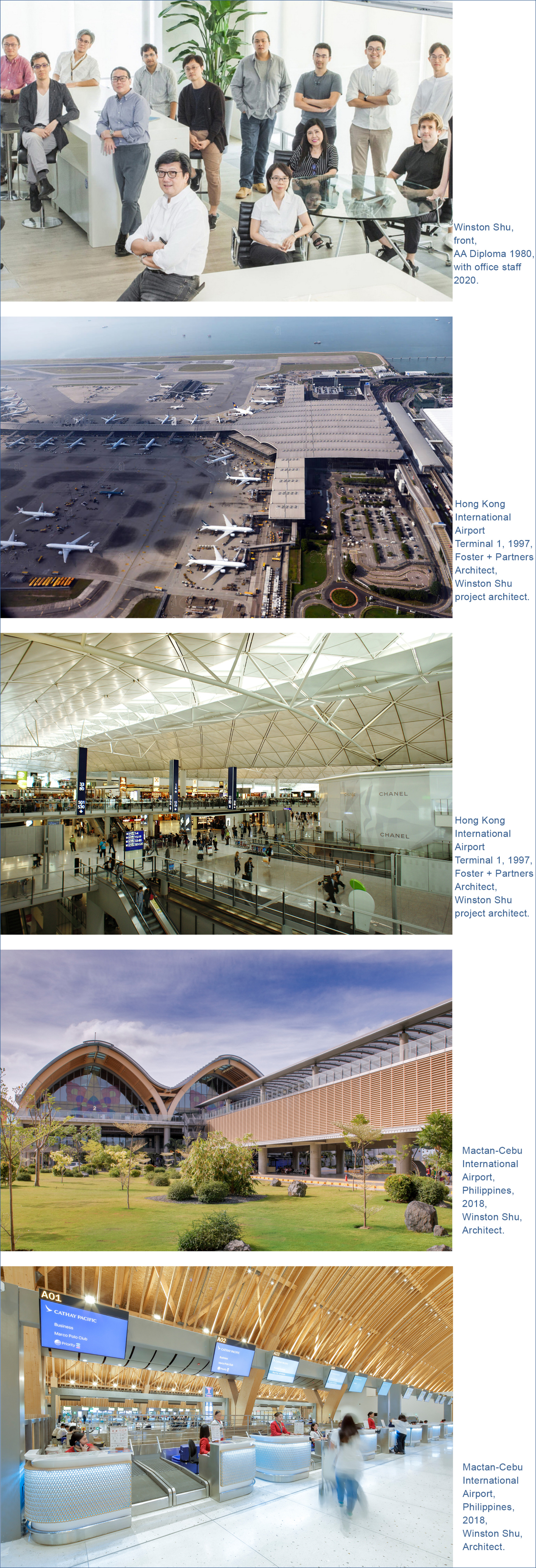
13 — The Rain Maker and The Rain
From the book “Drawing Ambience, Alvin Boyarsky and the Architectural Association”: “In a 1977 report, RIBA cited deficiencies in student drawings which lacked technical competence. Boyarsky rejected such criticism: “I don’t think the problem of architectural association is to teach people to be almost proto-professional operators, because that’s for them to work out as they go out into life.””
In fact this is as the RIBA contends, where the problem comes. Majority of AA students encouraged to dream ignoring the wide human society, either continue to reject conventional society as they go out into life, or do not find how to navigate wide human society and still produce final success, good architecture for humanity.
This article begins as a story of the Architectural Association, but when it is finished, it seems it is also a flashback of the life of Alvin Boyarsky, the AA School’s head teacher in 1970-1990. I hope Alvin Boyarsky would approve the story.
Despite international prestige, the AA School was paradoxically always in pain for even simple survival – World War 2, threat of closure in 1970, always struggling for architecture relevance. The school with a respected name, is in pain for relevance and survival, even in 2023 today.
